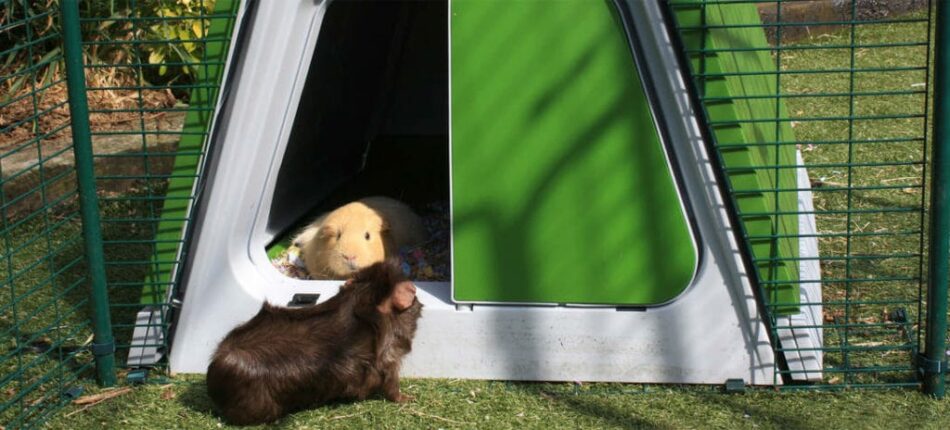
Trying to decide between male and female guinea pigs? It’s well known that guinea pigs do best in bonded pairs or small “herds”, but when it comes to selecting male or female cavies, things can get a little vague. Are there noticeable differences between the two? Can opposite genders be kept together? What are male and female guinea pigs called?
Male guinea pigs are called “boars” and female guinea pigs are called “sows”, just like their non-related namesakes. Boars and sows have slight differences in both appearance and personality. We’ll help you narrow down which to choose.
Physical differences
Guinea pigs somewhat resemble adorable potatoes. These plump, short-legged, bundles of energy have been known to provoke the humorous question: which end is the tail? Physical differences in their potato-esque bodies are subtle, but in general males will be larger than females.
Weight
Boars tend to weigh slightly more than sows – around half a pound heavier. Like other male animals, male guinea pigs may appear bulkier than females, even if they don’t weigh much more.
Length
Male guinea pigs can be slightly longer than females, however, this isn’t always the case. While a boar may appear larger than a sow, it’s usually by weight rather than length.
Behavioural differences
The most notable differences between male and female guinea pigs are seen through their behaviour and personalities. Here we’ll outline some of the most common behavioural differences between boars and sows.
Aggression
Males have testosterone, and boars that aren’t neutered have an abundance of it! This can sometimes lead to territorial aggression in male guinea pigs – both among cagemates and caretakers. A large guinea pig hutch and run is necessary when housing male guinea pigs together. Small enclosures can create strife between boars, so it’s best to give them as much room as possible. Secondary runs, such as the Zippi Guinea Pig Runs can be connected to their main enclosure through the Zippi Guinea Pig Tunnel System to give them plenty of space to spread out.
Female guinea pigs aren’t usually aggressive with each other, but each individual cavy is different. In general, sows live together amicably, but can occasionally exhibit territorial aggression if kept in enclosures that are too small for them. Like with males, giving female guinea pigs as much space as possible is always the safest option.
Trainability
Each individual guinea pig will have their own personality, but boars tend to be more outgoing and curious with their owners. Sows are generally more shy and content to hide out. Training guinea pigs is possible no matter what personality type your cavy has, but as a general rule, may be easier with males.
Appetite
Since boars are larger than sows, they’ll need to eat more. And, for reasons unclear to humans, male guinea pigs tend to get very messy with their meals. It’s not uncommon for boars to toss their pellets or spread their hay around their hutch and run. A Caddi Treat Holder is a great solution to serve fresh fruits and vegetables or hay to boars to reduce waste. Sows may not need to eat as often, but should still have quality pellets and hay available to them at all times.
Vocalizations
Guinea pigs have their own language that they try to impart to their humans. Any guinea pig can get vocal (especially around mealtimes), but males may be particularly loud. This is partly because of their more outgoing personalities, and partly because they are more robust by nature. Still, sows will make plenty of noises that only guinea pigs can muster!
Lifespan
On average, male guinea pigs have a lifespan of 1-2 years longer than females. However, the lifespan of all cavies is largely dependent on their diet, care, and environment. Guinea pigs often suffer from being overweight, which puts extra pressure on their small frame, so keeping them active is necessary for a long lifespan. Guinea pig accessories are an excellent way to add physical and mental enrichment to any guinea pig’s life.
Maintenance and care
Boars have a musky odour that is off-putting to many owners. This smell is the result of glands that are used in marking territory and attracting females – though not attractive to human noses! They’re also notorious for spilling food and water, and are perfectly content to stew in the mess they’ve created.
Many owners want to know how to reduce guinea pig smells, but an easy-to-clean guinea pig hutch is the best method for warding off unwanted odours. Wiping down the inside of the hutch and refreshing the bedding daily makes a huge difference in preventing unwanted smells from your guinea pigs.
Regular hutch cleanings are usually all that’s needed to keep your guinea pig looking and smelling fresh, but some cavies with longer coats may need additional care. It’s generally not advised to bathe a guinea pig regardless of gender or breed, but grooming your guinea pig can be a great bonding experience.
Both male and female guinea pigs can thrive outdoors all year round. A quality guinea pig hutch fosters their natural instincts, keeps them cool in summer and warm in winter, and gives them plenty of room to enjoy the outdoors. It’s common to see owners house their cavies inside, but guinea pigs thrive in an outdoor environment so long as their needs are met.
Guinea pig breeds and behaviour
Sometimes behaviour is more heavily influenced by the breeds of guinea pigs than their genders. No matter which breed or gender you choose, it’s important to meet the guinea pig you are thinking about adding to your family to get a feel for their unique personality. Many guinea pig owners find themselves surprised by bringing home a cavy that is neither the gender nor breed they originally planned on. The best practice is to bring home the piggie whose disposition complements your own.
Cohabitating
Because of their territorial nature, it’s best to have just a bonded pair of males, unless you have plenty of space to expand their territory. Small herds of females are another good option if you’re considering adopting more than a bonded pair. Sometimes, you may find a neutered male guinea pig in need of a home, or may consider having your boar neutered. Neutered males living together display less aggression, and can be housed with females without the risk of accidental litters. If you’re interested in having a male guinea pig neutered, be sure to find a veterinarian that is familiar with altering cavies – it’s not as common of a procedure for guinea pigs as it is for dogs and cats.
Omlet and your guineas
Omlet makes products that help you keep your guinea pigs healthy and happy. Our line of guinea pig products makes caring for your cavies fun and enjoyable. Whether you choose boars or sows, choose Omlet products to help them live their best lives.
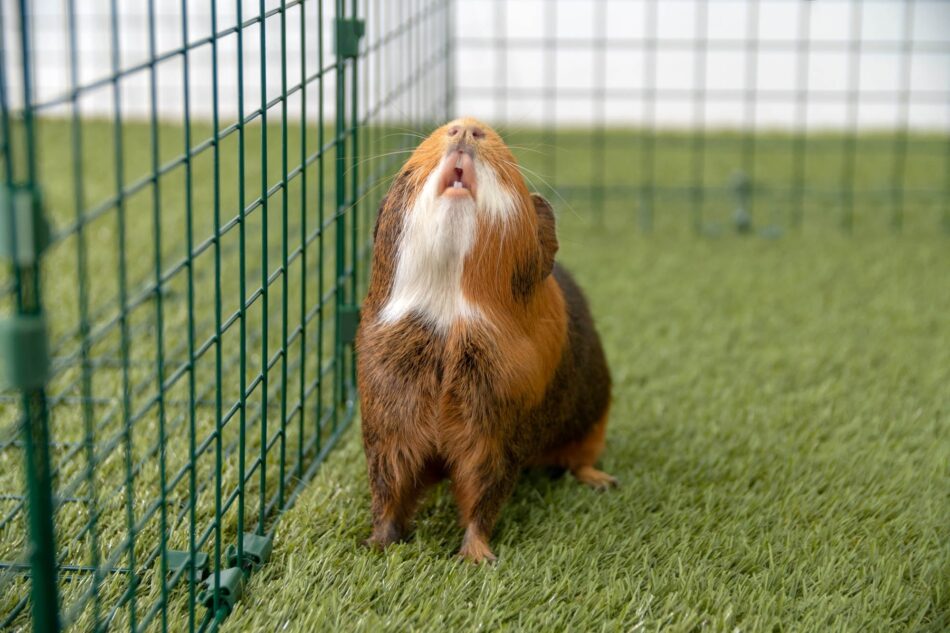
This entry was posted in Guinea Pigs
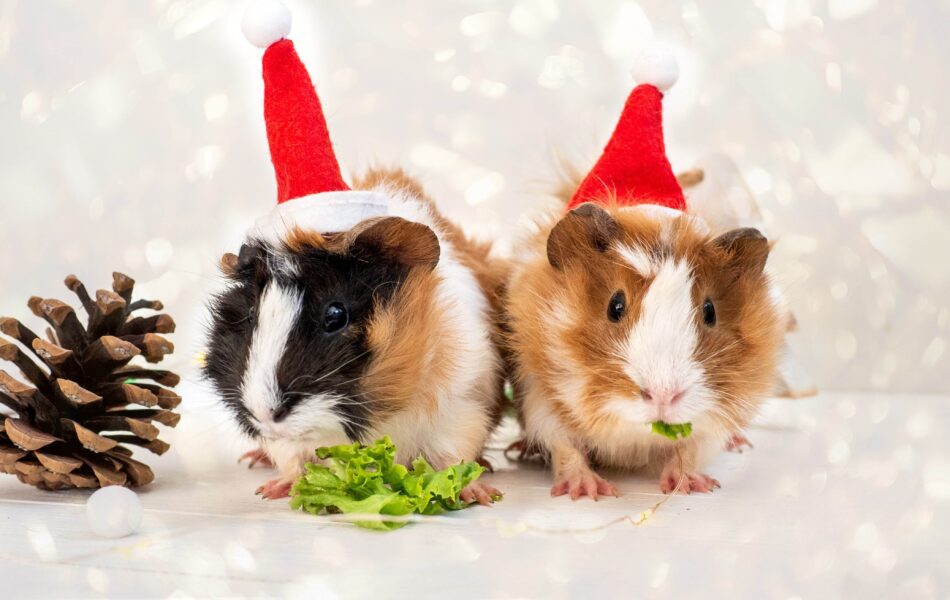
Christmas is the most magical part of the season. It’s the perfect time to snuggle up with your small furry friend and enjoy this special time of year.
And let’s not forget the food. Christmas is one of the biggest holidays for a “foodie,” and if you share a home with a rabbit or guinea pig, you know they’re foodies too. Thankfully, there are several festive treats that you can share with your food-loving friends – just hold the seasoning and spices.
What are your Christmas meal staples? If you’re like most, your Christmas spread probably includes turkey, stuffing, various vegetables, and sides, punctuated with decadent desserts. And with all that meal prep, there are lots of scraps and trimmings that you can give your rabbit or guinea pig as a special holiday treat.
Treats for your bunnies
Rabbits and carrots go together like turkey and gravy. But what other trimmings can you save for your bunny when you’re prepping for your Christmas meal?
Rabbit-safe Christmas meal ingredients that you can share with your bunny include: carrots and their tops (though in moderation, as carrots are high in sugar – which is why rabbits love them), celery, cranberries (fresh or unsweetened and dried), fresh green beans, and leafy greens such as lettuce and cabbage. And if your Christmas dinner doesn’t stick to the traditional menu, a list of rabbit-safe foods can be referenced to see what you can feed your bunny from the kitchen.
The easiest way to keep your rabbit’s treats separate from what gets tossed and what gets seasoned is to keep a bunny bowl on the counter. Any trimmings that are meant for your rabbit can be scooped into a bowl and offered once you’re done with your meal prepping – just make sure all of your helping hands in the kitchen know what this is for.
If you’re really feeling festive, you can also find many recipes online for rabbit-friendly baked goods like carrot cake or banana treats to make their holiday extra special.
Guinea pig goodies
Guinea pigs follow a diet that resembles a rabbit’s, except that they need more vitamin C as they cannot manufacture their own. The same foods that you reserve for your rabbit can be safely offered to your guinea pig, but some additional considerations for cavies are: small amounts of orange or orange peel, bell peppers (yellow, red, or orange are best), broccoli, apple slices, and berries.
Part of the cuteness of cavies is their build, but with their little legs and larger bodies, it’s important not to overfeed them. Ideas for guinea pig baked goods can also be found online, but any holiday goodies should be served as a one-time treat.
Keep a cavy cup handy in the kitchen during holiday baking and meal prep. If possible, refrigerate excess scraps to offer at a later date if your cup “runneth over!”
Holiday hazards
While there are many delicious and nutritious foods to share with your rabbit or guinea pig, there are also holiday staples that should not be shared. Avoid feeding:
- Nuts and seeds
- Potatoes (especially if raw)
- Sugary or baked goods
- Bread
- Meat
If your rabbit or guinea pig happens to sneak a taste of something they shouldn’t, identify what it was and how much they ingested and call your vet. Christmas is the most common time of the year for pets (large and small) to get into something they shouldn’t, so take precautions to ensure your bunny or cavy aren’t able to sneak a bite. Make sure your rabbit or guinea pig is safe in their hutch or run, or set up a rabbit or guinea pig playpen to keep your furry family members out of the kitchen and away from falling foods and cooking utensils.
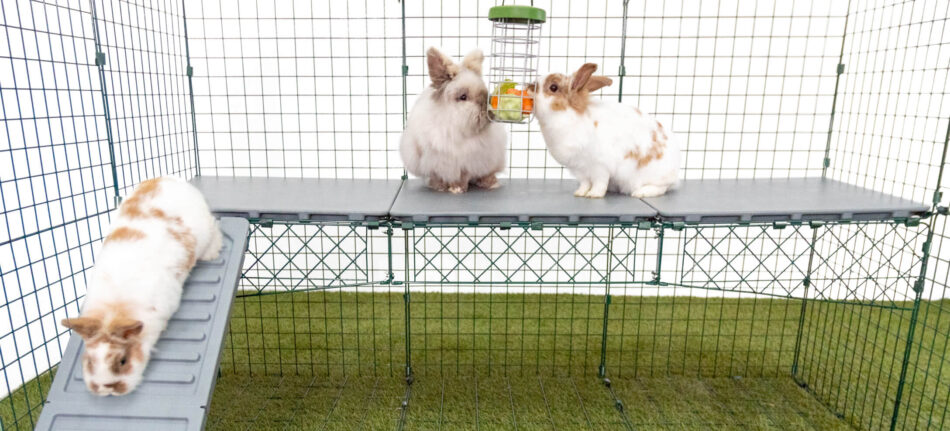
Special occasion treats and year-round feeding
Rabbits and guinea pigs both need a quality pellet feed (ideally timothy hay-based), and unlimited access to timothy hay or orchard grass and fresh water, with guinea pigs needing additional vitamin C. Around 90% of both your rabbit and guinea pig’s diet should consist of these staples, with treats being given no more than a few times a week.
The best treats are those that incorporate into a well-balanced diet for bunnies and cavies, such as vegetables or fruits that offer nutritional value. Anything indulgent should be offered on special occasions like holidays or your pet’s birthday – otherwise, it might upset their digestive systems or influence their food preferences.
Feeding treats in a Caddi rabbit treat holder or a Caddi guinea pig treat holder is a great way to keep their favourite treats together and up off the ground. It’s also a nice “plating” option when serving up special holiday fare.
A home for the holidays
The holiday season should be a time of comfort and joy for both you and your furry family members. This time of the year also brings colder temperatures and freezing precipitation, so be sure your rabbit or guinea pig is housed in an insulated rabbit hutch or guinea pig hutch for optimum cosiness. And bring on the joy with Zippi tunnels and playpens for endless fun so guinea pigs and rabbits can warm up their bodies and appetites.
With a warm home, full bellies, and loving humans, your small furry family members are sure to have the best holiday season.
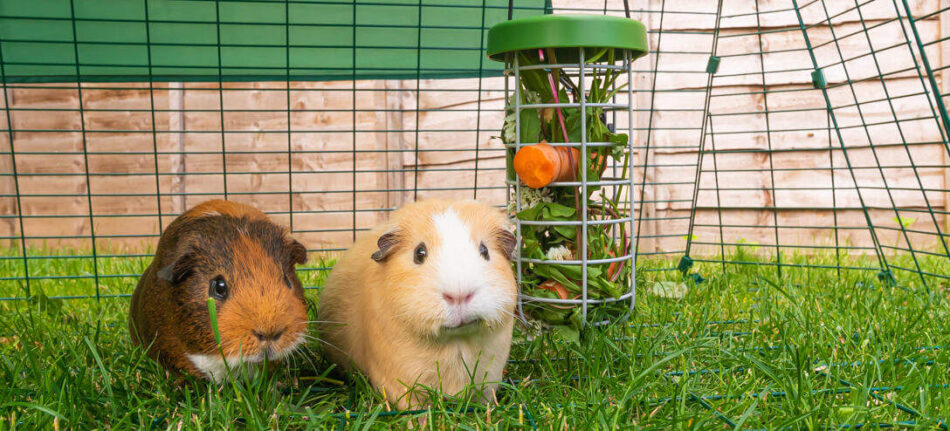
This entry was posted in Christmas
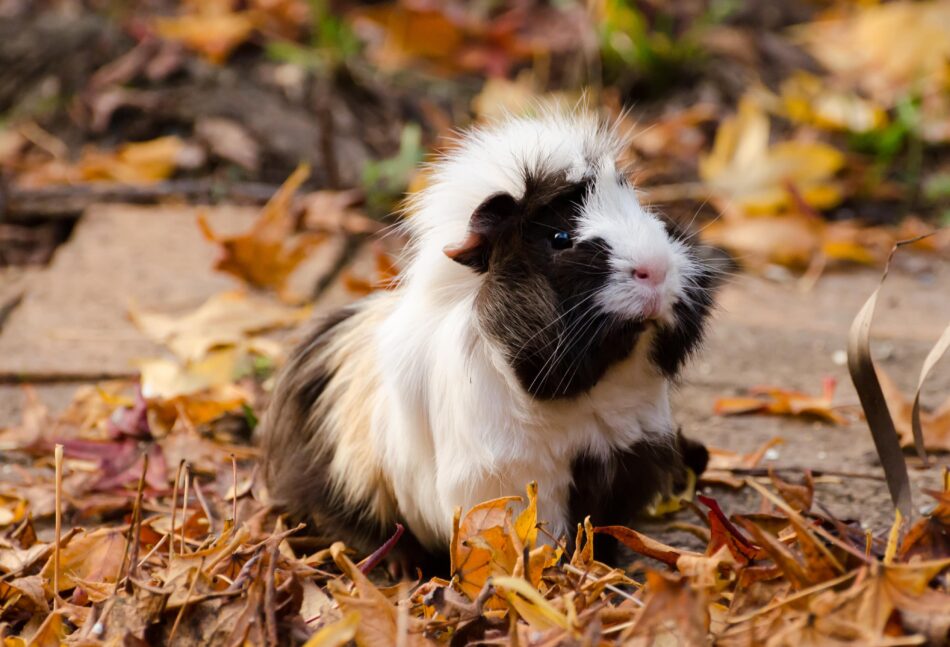
Did you know that there are many different breeds of guinea pigs? There are actually 13 breeds recognized by the American Cavy Breeders of America (ACBA), and several other varieties that have emerged through selective breeding. Some are larger than others, and their personalities differ slightly between breeds – but overall the biggest difference between types of guinea pigs is their coats. A guinea pig’s fur can be short, long, straight, curly, or in the case of “skinny pigs,” non-existent!
Some guinea pigs have such long hair that they appear as though they’re wearing skirts, and some have tight, curly hair that gives them a fluffy appearance. Among the 13 recognized breeds from the ACBA, 5 are long-haired, and 5 are textured! So what people commonly think of when they visualize guinea pigs (short hair with various markings), is actually a minority of guinea pig breeds.
“Skinny pigs” (hairless guinea pigs), dalmatian guinea pigs, and fox guinea pigs are all examples of “experimental” breeds that have emerged recently. Experimental breeds are those that are selectively bred for a desired trait, and once that trait can be replicated for several generations, can one day become a recognized breed at a national level.
Even though some breeds may require more grooming than others, on the whole guinea pigs remain one of the best starter pets for children, and some of the easiest small animals to take care of. Discover the many coats of cavies, and how to choose the right guinea pig for you!
Hair or fur?
Does a guinea pig have hair or fur? Or is there a difference?
Hair is an individual component of fur, which is the collective term. Technically all mammals have fur, because they are covered in hairs – including humans! Hair can also be defined as ever-growing length that is independent of fur, which grows to a definitive length and does not require trimming.
Like most mammals, guinea pigs have fur that covers their bodies. In fact, they are precocial, which means they are born with fur, teeth, and the ability to walk! But longhaired breed guinea pigs have coats much like longhaired dogs and cats that grow continuously throughout their lives.
The fur on guinea pigs serves the same purpose that it does in all mammals – insulation, protection from elements, and of course, visual appeal! But one type of guinea pig, known as the “skinny pig,” has actually been bred to be completely hairless, save for the occasional patch of fur around their ears or muzzles. Since they don’t have fur, skinny pigs are not good candidates for living outdoors, as they cannot regulate their temperatures without fur for insulation. But, even though they might not come in the variety of colours and textures as their clothed-cousins, they still have the cuteness factor!
Do guinea pigs shed?
Guinea pigs shed seasonally just as other household pets do. A guinea pig will release the dense undercoat they grew for the winter come spring, and will shed throughout the summer as the weather warms. By brushing your guinea pigs regularly, you can assist them in ridding their coats of excess hair.
Shedding shouldn’t be a concern unless your cavy is shedding excessively in the cooler months, or if they are losing hair to the point of having bald patches. If you notice your guinea pig scratching or pulling at their coat, or notice any red or irritated skin, contact your veterinarian.
Can guinea pigs change colours?
While patterns and base colours remain the same, the shade of your guinea pig is likely to change with the seasons – and some changes might actually be permanent!
When a guinea pig is about 3 months old, they will shed their baby fur and grow an adult coat. Sometimes they can change colours entirely during this progression! Seasonal shedding can also alter the appearance of your guinea pig due to the decreased presence of their dense undercoat. As your guinea pig ages, each shedding and regrowing season may bring a new hue to their coat, which can be a permanent change.
The only colour change you should be wary of is yellow, as this indicates urine staining on your guinea pig. Make sure you change their bedding frequently so that they don’t stand or lay in their urine to avoid staining their coat and inviting bacterial infections to start.
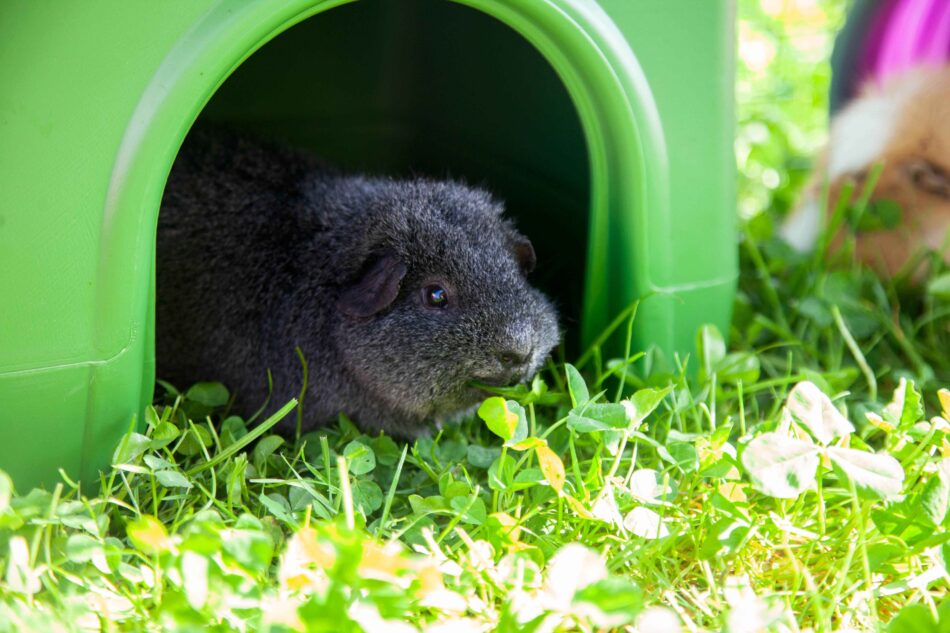
Short-haired guinea pig breeds
There are three officially recognized breeds of short-coated guinea pigs: American, American Satin, and White Crested. The American breed is the most common, and is known for its gentle and docile temperament and low-maintenance coat. They are also known to be very friendly with other guinea pigs, which makes them a great choice if you already have a guinea pig or two.
Other breeds of piggies that are considered short to medium-haired have textured coats. These breeds are: Abyssinian, Abyssinian Satin, Teddy, and Teddy Satin. Abyssinian guinea pigs have whorls (officially known as “rosettes”) that look like cowlicks all over their bodies, giving them a quirky appearance! Teddy breeds have very dense and velvety coats with lots of volume – the density of their coat makes it stand up and away from their bodies, in a very “plushy” look. Satin breeds have a sleek and shiny coat in addition to their breed-specific patterns or traits.
Long-haired guinea pig breeds
Guinea pigs with long hair require more maintenance than those with shorter coats, but if you keep up with their grooming, they are remarkable to behold! Piggies with long, luscious locks include: Coronet, Peruvian, Peruvian Satin, Silkie, Silkie Satin, and Texel.
All of these breeds (except Texels), have long, flowing locks that give them a “walking-mop” appearance. Both striking and adorable, some of these breeds can have coats up to 24 inches long! One of the smallest breeds of guinea pigs, the Texel makes up for its size difference in astonishing curls that hang in ringlets from their bodies. Their coats can be combed or brushed into waves, or be detangled gently to keep their bouncy, corkscrew curls.
All long-haired guinea pigs share the same friendly and easy going demeanour as their short-haired cousins, but some are known to be a little mischievous if they become bored! Like all cavies, long haired guinea pigs need enriching activities that challenge both their minds and bodies. Guinea pig treat holders are a great way to encourage foraging and to stretch out little legs and backs while keeping hair out of their snacks!
How do I groom my guinea pig?
Both long and short haired guinea pigs need some routine grooming. They don’t need to be bathed often – in fact, you want to avoid giving your guinea pig a bath unless they have urine-stains or got exceptionally filthy. Frequent bathing can dry out their skin and open themselves to bacterial or fungal infections more readily. This is especially true for hairless guinea pigs, which should never be bathed.
When performing routine grooming for your guinea pig, you’ll want to focus on their: teeth, nails, coat, and face.
Don’t worry – you don’t have to go out and find a tiny toothbrush for your cavy! You’ll just want to watch your guinea pig munch on a treat, or hold them gently and pull down their bottom lip to make sure they aren’t getting “long in the tooth.” Like all rodents, their teeth grow continuously, and they chew and nibble on things daily to wear them down. A healthy guinea pig mouth should have white teeth with minimal overlap in the front. Minor tooth staining is normal for cavies eating fruits and vegetables, and isn’t a cause for concern unless the entire tooth is affected.
Regular nail trimming should be part of your guinea pig’s grooming routine. Cavies that live outside, or that have ample room in a guinea pig run will need less frequent nail trimming, as they will wear them down while they’re running and playing. When you trim your guinea pig’s nails, make sure that you can see the blood supply (the “quick”) so that you don’t accidentally nick them. And don’t try to trim the nails on a restless guinea pig – wait until they are relaxed and comfortable being in a good position to handle their nails. This may take some practice sessions without actually trimming their nails (treats go a long way!).
Coats of short-haired guinea pigs may need to be brushed in the spring or summer when they shed their undercoats, but it usually isn’t necessary to brush them on a regular basis. Long-haired guinea pigs should be brushed several times a week, depending on their housing conditions and length of their coat. Consider using recycled paper or pine pellets for bedding in long-haired guinea pig homes, as shavings can become tangled in long hair.
To finish up your grooming routine, check your guinea pig’s face for any discharge from the eyes or nose. Clear drainage is normal, but if you notice white or yellow discharge, contact your veterinarian.
Grooming your guinea pig will help strengthen your bond and ensure that your cavy is in good health. Think of each grooming session as another chance to build trust with your guinea pig, and for you to do a brief examination of their health.
Making care even easier and more fun
Guinea pigs are some of the easiest pets to care for – and some of the most enjoyable! You’ll be rewarded with “wheeks” and “chuts” and “popcorning” as part of a language unique to guinea pigs, and probably a cuddle or two!
As with any pet, starting with a good foundation is key. A quality guinea pig hutch is essential in providing the best care for your cavy. Guinea pig shelters and tunnels make for functional accessories that make your guinea pig feel more comfortable in their environment, while providing them with mental and physical exercise.
Have you decided on which breed of guinea pig to add to your family? Let us know below!
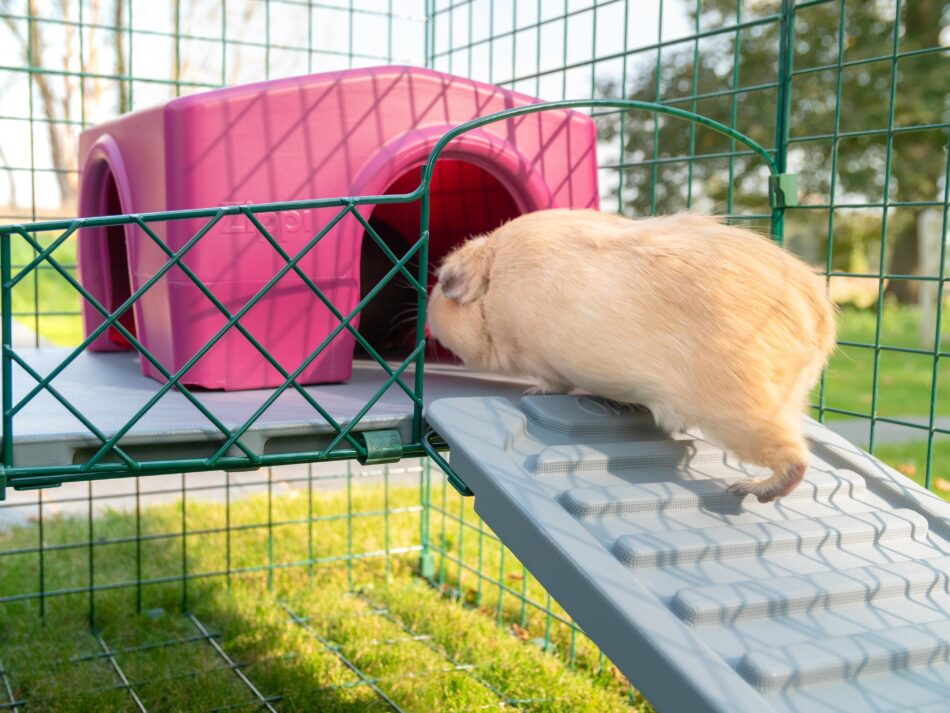
This entry was posted in Guinea Pigs
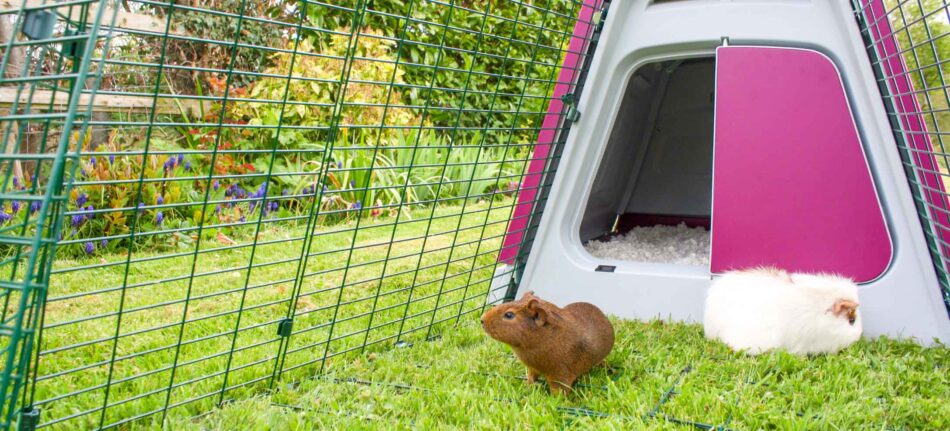
Guinea pigs make for incredibly entertaining and enjoyable pets. They’re highly social, recognize (and “talk” to!) their humans, and are capable of learning tricks and basic commands. So why would anyone want to part with one?
Like any pet, guinea pigs are an addition to a family and require care and attention. Adding any pet to a family is a big commitment! Cavies (a shorthand name of the scientific name for guinea pigs) make excellent pets for children, as they are known for their gentle dispositions and adorable personalities. But unlike other small pets, guinea pigs have a long lifespan for rodents: up to 8 years! Compared to a shorter life span of 2-3 years for hamsters or gerbils, families often don’t realize just how long a guinea pig will be part of the family. Guinea pigs also require more space than pocket-pets, eat more, and prefer to be kept in pairs or small groups. And, if not provided with enough enrichment and opportunities to exercise, they become bored and will vocalise their displeasure! For these reasons, hundreds of guinea pigs are surrendered to shelters and rescue groups every year, hoping to find their forever homes.
Reasons to rescue
Adopting a guinea pig is one of the most noble and commendable ways to become a proud owner of a cavy (or two)! Shelters are not usually equipped with the necessities to keep a cavy comfortable, and are noisy/scary places for a small pet!
You can help by adopting a guinea pig directly from the shelter, or from a rescue group! Your adoption/rehoming fee goes directly back into the organisation’s funds for feeding, caring for, and rescuing future pets.
Are you on the fence about owning guinea pigs? You may be interested in fostering one or two! Fostering guinea pigs takes the pressure of being a permanent home off of you, while still providing a safe place for them while you find their perfect home. Check with local guinea pig rescue organisations to see if you can join their list of foster homes – many of them will help you financially care for the guinea pigs you foster, or offer supplies such as bedding and food. It’s also a great opportunity to see if owning a guinea pig is right for you!
Adopting vs. shopping
You’re probably familiar with the campaign of “adopt, don’t shop” that shelters and rescue groups use for finding homes for dogs in particular. While there’s nothing inherently wrong with “shopping” (purchasing from a breeder or store) to obtain a guinea pig, there are plenty of cavies in need of forever homes if you know where to look.
Animal shelters and adoption centres near you can be found online. Be sure to ask them if they have any guinea pigs available – just because they aren’t listed online doesn’t mean they don’t come across them!
Rescue groups or individuals are also great resources when looking to adopt a guinea pig, and will usually offer continued education and assistance after you adopt through them. These groups or individuals can be found through an online search, Facebook groups or through your local shelter or veterinarian.
It’s important to check the credibility of a rescue group or individual before adopting from them. You can ask a group for their non-profit status and to check the efforts of an individual, ask them for references and/or ask them which veterinarian they take their cavies to. When you call the veterinarian’s office, they should be more than happy to verify that the individual brings guinea pigs in for care.
A coat for every occasion
Choosing the right guinea pig breed isn’t entirely necessary, but it is fun! Guinea pigs all have unique personalities, but are universally known to be sweet, good-natured pets. Breeds have primarily been developed for different coat types – and there are many different varieties! Choosing the right breed for your family really comes down to how you want your guinea pig’s coat to look, and how much time you’d like to spend grooming and brushing them. Coats range from long to short and straight to curly – with some guinea pigs having no hair at all!
If there’s a particular breed with a coat that appeals most to you, you may want to go through a breeder or a rescue group that really knows their cavies! Still, in checking with shelters and rescues routinely, you may stumble upon your perfect piggy – or one that steals your heart regardless of their hair! Be sure to ask the shelter or rescue to put your name on a list if you are searching for a specific type of guinea pig.
The main attributes to consider when adopting a guinea pig are:
Is it a young or senior guinea pig? Are you adopting more than one? If so, be sure to get same-sex pairs to avoid accidental litters of guinea pig pups! And is the guinea pig you’re considering outgoing or shy?
Finding a guinea pig that fits into your lifestyle and meshes with your family is the most important part of choosing your cavy. Even if the guinea pig you see at the shelter or rescue isn’t the one for you, you can spread the word on social media to help it find its forever home!
Prepare for “popcorning”
If you aren’t familiar with guinea pigs, one of the most adorable things they do when they’re happy is something called “popcorning.” When a guinea pig is at their happiest, they will quite literally jump for joy – twisting and grunting to form the action known as a guinea pig “popcorn.”
So how do you get your piggy to popcorn? You help them live their best life through shelter, play, diet, and basic care!
By choosing a high-quality enclosure like the Eglu Go Guinea Pig Hutch from the beginning, you’ll avoid having to replace it down the road. We invented this hutch with the spirit of enabling guinea pigs to enjoy nature safely and securely.
That’s right – you can house your guinea pig outside, all year long! It’s a common misconception that guinea pigs have to be housed indoors, but they’re actually quite capable of adapting to life outside! The added benefits of having an Eglu Go Guinea Pig Hutch include: weather and predator protection, anti-gnawing and chewing design, and being super easy to clean!
Regardless of whether you keep your cavy indoors or outdoors, they’ll need engaging activities to exercise their minds and bodies. Since guinea pigs love to tunnel (but not dig their own!), a system of Zippi Guinea Pig Tunnels is an excellent way to curb boredom and move those little legs! Combine the tunnels with Zippi Guinea Pig Runs and Playpens for safe, enclosed playtime – inside or outside!
Setting up an enriching, safe place for your guinea pig will help them adjust easier and faster, which allows you to spend less time cleaning and more time playing and bonding with them!
Caring for your cavy
Once you have all of the proper equipment, guinea pigs are relatively easy to care for. Their diet should consist mainly of ruffage such as Timothy hay, fed in unlimited amounts. They should also be fed a hay-based pellet that is high in fibre to keep their little bellies in working order.
Like humans, guinea pigs cannot manufacture their own vitamin C, so make sure that their pelleted food has added vitamin C. If not, commercially purchased supplements can be fed or added to their water. You can also offer vegetables high in vitamin C such as bell peppers, tomatoes and asparagus. Fruits are a source of vitamin C as well, but should be fed sparingly as it’s very easy for a guinea pig to become overweight! Small amounts of oranges or kiwi may be given once or twice a week for a treat that packs a dose of vitamin C.
The Caddi Guinea Pig Treat Holder is a fun way to offer up your cavy’s favourite foods. Stuff it with hay, leafy greens, or other guinea pig-safe delicacies for hours of fun. When you’re as cute as a guinea pig, it’s okay to play with your food!
In addition to their diet, you should make sure your guinea pig always has access to fresh, clean water. Avoid any bowls low enough for them to step in, tip over, or kick bedding into. Run-mounted crocks or drinkers are good options for offering water to your cavy. You can also use an elevated cat bowl to offer water inside of your guinea pig’s hutch, as long as it’s high enough to keep them from taking a dip, and low enough for their mouths to reach!
Exercise is important for a guinea pig so that they maintain a healthy weight. Extra ounces on a guinea pig can lead to metabolic or digestive issues, and put unnecessary strain on their little legs which can cause joint pain. Zippi Guinea Pig Platforms are a great way to encourage your guinea pig to put in some extra steps! Try serving their food on the platform to encourage them to climb up and down the ramp. You can also build obstacle courses out of cardboard boxes to encourage physical activity – just be sure there’s a reward at the end!
Basic grooming and health checks will ensure your guinea pig is feeling its best. If you find anything amiss during a routine once-over, be sure to notify your veterinarian. For a list of these basic activities, visit: 5 Guinea Pig Care Tips.
Build a bond that lasts a lifetime
To ensure you and your newly-rescued guinea pig get off on the right foot, remember to:
- Choose a high-quality hutch designed for guinea pigs
- Offer stimulating and enriching enclosures and playtime
- Feed an appropriate diet
- Find a veterinarian that treats guinea pigs in case of illness or emergencies
When all of a guinea pig’s basic needs are met, you’ll find that they make wonderful companions! They have many adorable attributes such as popcorning, scampering, playing, and chattering (see: How to Understand the Language of Guinea Pigs).
By nature, guinea pigs will bond with another of their kind, which is why it’s best to keep them in pairs. Having a pal that speaks your language is great, but cavies also desire and build relationships with their human-caretakers! Talk to your guinea pig often, offer food by hand (careful not to accidentally put your finger in harm’s way), and visit with your guinea pig frequently. Above all, be patient. Bonding with any animal doesn’t happen overnight, but before long your guinea pig will accept you as their friend. Once a bond has been established, it is not easily broken, so take your time. Your piggy will be greeting you with a series of “wheeks”, “chuts”, and “coos” in no time – especially if there’s food involved!
Confidence and support
Adopting a guinea pig is a big decision, but with adequate resources and preparation, it can be one of the most rewarding decisions you’ll make as a pet owner!
We’ve created our products to help your guinea pig adjust to life in their forever home. Because our hutches are meant to be a “forever” solution – no rotting, breaking down, or showing the wear and tear of wooden hutches – you can have the confidence that your adopted cavy is living safely and happily ever after in their new home.
We hope that you take the leap and open your home and heart to a guinea pig in need of rescuing. If you have any questions about how to adopt a guinea pig, or basic guinea pig care, let us know!
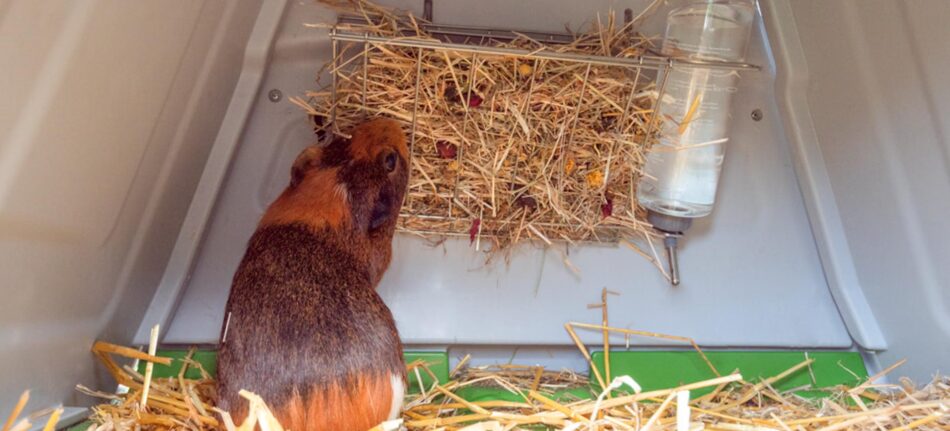
This entry was posted in Guinea Pigs
With just a few weeks until we fall into the most magical season of all, now marks the perfect opportunity to get your guinea pigs winter-ready. Finding the ultimate cosy coat is one way we can prepare for the season ahead, but for our furry friends, the preparation is, of course, slightly different. And whilst your cavy already has a soft, fluffy coat of their own, this doesn’t mean they can brave the colder temperatures without our help.
Have you thought about winter from your guinea’s eye view? Frost, rain, wind. We know that this season can be a difficult time, but getting your pet winter-ready doesn’t have to mean a complete transformation of their autumnal hideaway to a brand new winter wonderland. Don’t let the weather stop you from making magic moments with your pets this season, and with these simple steps, your guineas will be popcorning with joy into winter and ready to brace the change.
Do guinea pigs like winter?
If you could translate your guinea pigs’ purrs, whistles, and coos, they’d tell you that their favourite temperature is somewhere around 15-24 degrees celsius. And whilst in their natural habitat of the South American Andes, guinea pigs’ ancestors would cuddle up to each other to stay warm. Nowadays, they have become accustomed to their new environment, so we need to take extra care as the temperature drops below their optimal level. Therefore, it’s important that you take the right steps to make sure your cavy isn’t cold.
Can guinea pigs live outside in winter?
Omlet’s Eglu Go Guinea Pig Hutch has been designed as an all year home. For hutches unlike the Eglu which has twin wall insulation, it’s advisable to move your piggies into a shed or garage in the upcoming months. But, before you do so, you should know that these pets aren’t well-versed in adapting to recurring and drastic changes in temperature. Therefore, being brought in, then out, then in…and out (!) is harmful. This is because a sudden drop in temperature can make your guineas pigs sick . You should either bring them in for the entire winter or for a few weeks when it is very cold. Take a read of our Where To Put My Guinea Pig Hutch guide, so that you pick the perfect spot for your cavies’ winter retreat.
Preparing for winter
Your guinea pigs are ready to grow their thicker winter coat and you’re side-eyeing the thermostat …so what now?
Invest in warm bedding
It’s time for the winter bedding for you and your guineas. Warm bedding is a winter must-have for us and our guinea pigs, so be sure to stock up on extra bagfuls to line their home. It’s especially important that this stays clean and dry.
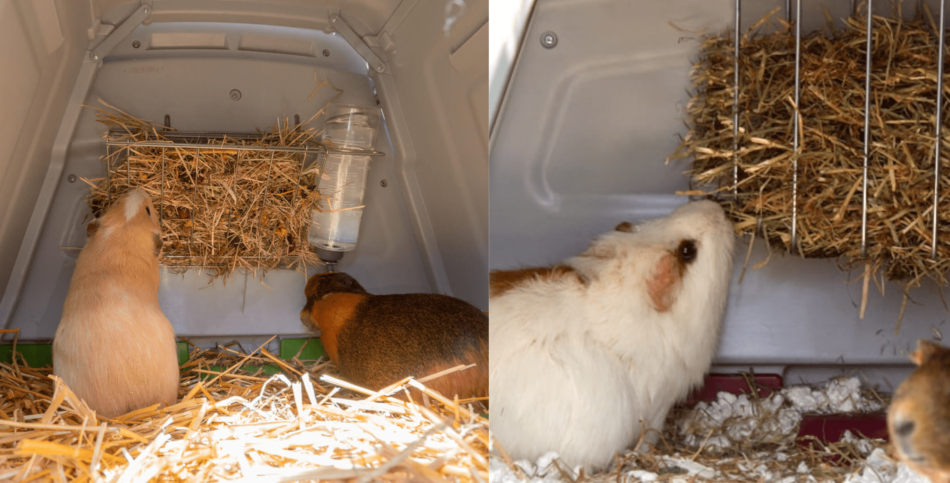
Get a bottle cover
As the weather gets colder, keep an eye on your guinea pigs’ water bottles. Freezing temperatures can lead to the metal spout and the actual water becoming frozen, inevitably meaning your cavies won’t have access to one of their basic needs. Not only will a water bottle cover mean their water bottle won’t freeze in winter, but also doubles up in summer to keep their drink nice and cool!
Avoid the grass
Your guinea pigs may have had a summer of fun exploring all the luscious green grass of the garden, but winter is unfortunately not the time for outdoor exploring. Putting your guinea pig down on grass when it’s especially cold or damp isn’t wise. For one, it’s uncomfortable for your guinea pig. It can also, however, lead to illness. Since these furballs have sensitive skin, getting it wet on a regular basis can be detrimental, in combination with being cold and not being able to dry off quickly. This doesn’t mean winter can’t be entertaining for your guinea pigs though! Check out our range of guinea pig toys for some indoor play inspo.
Keep on top of their diet
Guinea pigs should be fed a balanced diet all year round, including the essential nutrient vitamin C. We even wrote all about why vitamin C should be a staple in your guinea’s diet! Vitamin C aside, stocking up on plenty of calories is super important during the colder months as cavies burn more calories in order to stay warm. You should continue to feed them both fresh and dry food every day, as well as an unlimited supply of hay, but a few extra calories this season won’t hurt anyone!
Use hutch covers
Covering your cavies’ hutch is another way to keep them warm during winter, so it’s a good idea to invest in an extreme temperature jacket. This can be wrapped over the hutch and provides further protection to your Eglu Go. If you don’t have an Eglu, you can hang a roll of carpet over the hutch, or use a blanket, which you can nail down to keep in place. Please note however, that guinea pigs must have ventilation in their hutch at all times.
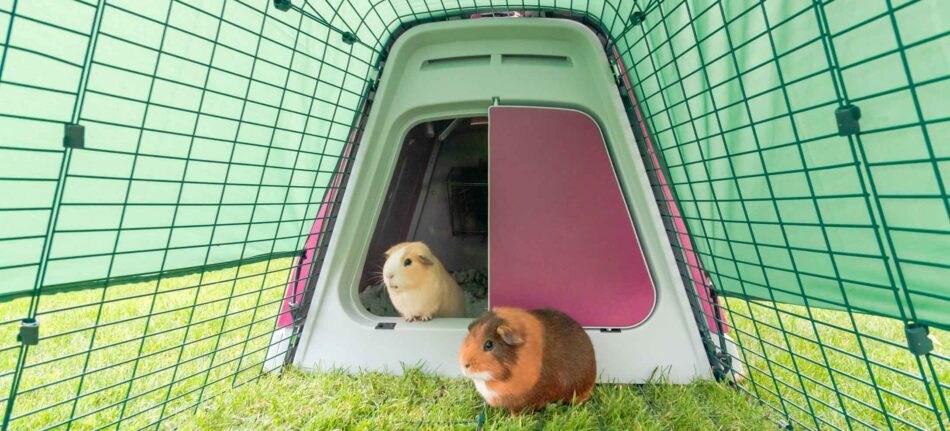
How to tell if a guinea pig is too cold
Before the big chill sets in, taking these measures to keep your cavies cosy will mean an enjoyable winter all round. But, it’s still good to know how to tell if your guinea pig is feeling a little frosty.
Whilst we don’t speak the same language as our pets, they’re fantastic at communicating their emotions, likes, and dislikes. Guinea pigs are no different and will use body language to tell you they could do with some warming up! Just like us, guinea pigs will shiver when they’re cold, as well as curling into a ball, known as huddling. Alternatively, your piggies might craft a makeshift blanket with their bedding in an attempt to warm their body temperature. You should also feel their ears, and if they’re cold, then you guessed it, the rest of their body is cold too.
Now that your cavies are winter-ready, it’s time to enjoy the best parts of being a guinea pig owner, knowing that your furry friends will be happy, safe and warm this season.
This entry was posted in Guinea Pigs
One of the most commonly asked questions from pet parents of smaller breeds of animals is whether or not rabbits and guinea pigs can live together. They are both small, cute and cuddly, live in hutches (or a super stylish Eglu Go Rabbit Hutch!) and like vegetables but that is pretty much where the similarities end.
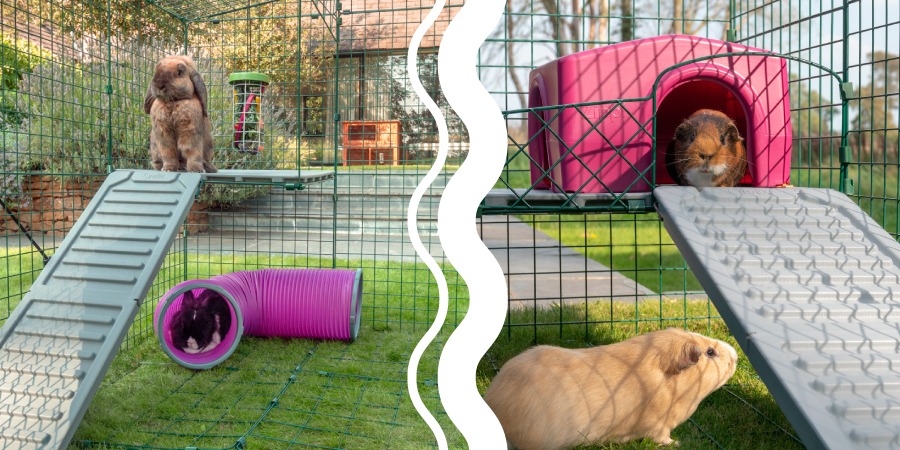
It used to be fairly standard practice for Guineas and Bunnies to live together, this was because neutering smaller animals wasn’t seen as a safe option. Things have most definitely changed since then and this is no longer a concern. The other reason behind this cohabitation is that the saying “breeding like rabbits” is very true! It was thought that by keeping guinea pigs and rabbits together it would prevent mass breeding.
A rabbit’s reproductive cycle is pretty fast, almost immediately after giving birth they can conceive again, and even though the average litter size is 5, it could be even higher! The largest recorded rabbit litter is 24, born to two New Zealand rabbits!
So, if a plethora of bunnies is not for you then your option would have been to let them share the living space with a guinea pig. It’s company after all, right? Wrong, in an ideal world, it would be perfect, however, it is not always meant to be.
Rabbits and Guinea Pigs are not really recommended to share their living quarters. Here, we look into the reasons behind why this seemingly suitable match made in heaven and lifelong friendship, won’t always be ideal.
They have different diets
Many consider these small pets to be similar in many ways, however, their dietary needs are quite different. Even though both mammals require hay, vegetables and fruit for a balanced diet there is something fundamentally different about how they process their vitamin intake.
Guinea pigs need Vitamin C to ensure they have a healthy diet because just like humans, they are unable to synthesise the vitamin alone, due to a gene deficiency. Vitamin C is found in citric fruits and is necessary for survival. Rabbits, on the other hand, can synthesise this particular vitamin, and if they are given too much then it could make them sick.
Housing them together and allowing them to share a food bowl, may only be meeting the needs of one, which could cause health problems down the line for the other.
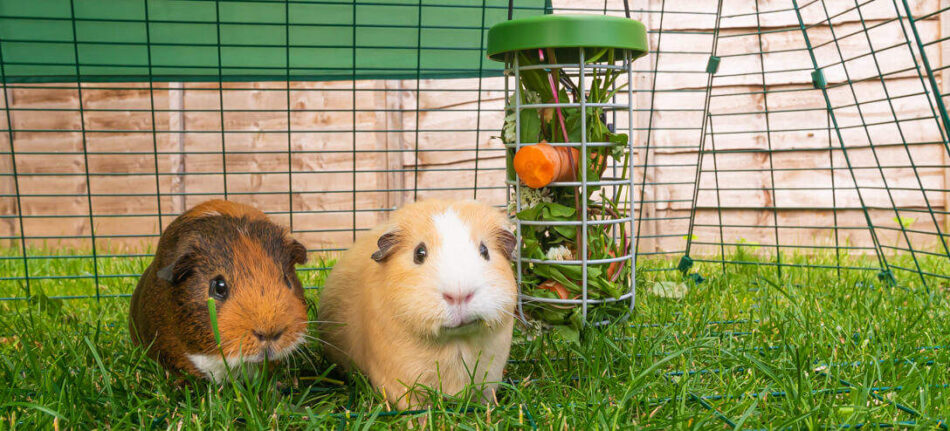
Rabbits bully guinea pigs
This may seem like a bold statement, but it is a possibility and one to be wary of. Our floppy-eared friends are bigger and somewhat stronger than their smaller counterparts. When it comes to food, especially if they are sharing, Peter Rabbit could quite easily push little Mini Guinea out of the way and assert their authority over them. This would result in a tempestuous relationship, especially if your guinea pig is being deprived of food!
Rabbits also love to bounce and hop around as they are very energetic creatures, so playtime could be slightly one-sided and maybe a little rough for your guinea pig who is a little more docile.
They communicate differently
Picture this, you’ve got your feet up, you’re comfortable and have a cup of tea on the side and are ready to read the Sunday papers, and all of a sudden your housemate decides to throw a Hawaiian themed party and invite the whole neighbourhood. That’s a little bit like living with a rabbit (from the perspective of a guinea pig!). Despite both being quite sociable little creatures, guineas do like their own space and time to relax, whereas rabbits tend to thrive from attention, either from regular mating or huddling together with their companions, grooming each other. This type of behaviour can be quite stressful for a guinea pig.
They are a different species after all and will not speak the same language. If they cannot communicate with each other then they could suffer from boredom and loneliness. Whereas if there are lots of rabbits and guinea pigs they will feel happier being with their own kind.
There are health risks
Both animals can be affected by Bordetella bronchiseptica which is a bacterial infection that can lead to bronchitis. It is more severe for guinea pigs, whereas rabbits display very few symptoms.
Another potential threat is Pasteurella which is passed through saliva, for example biting. Again, this is less of a threat to rabbits but more dangerous to guinea pigs. If rabbits and guinea pigs are living together, it could cause health risks which could be detrimental to a safe environment.
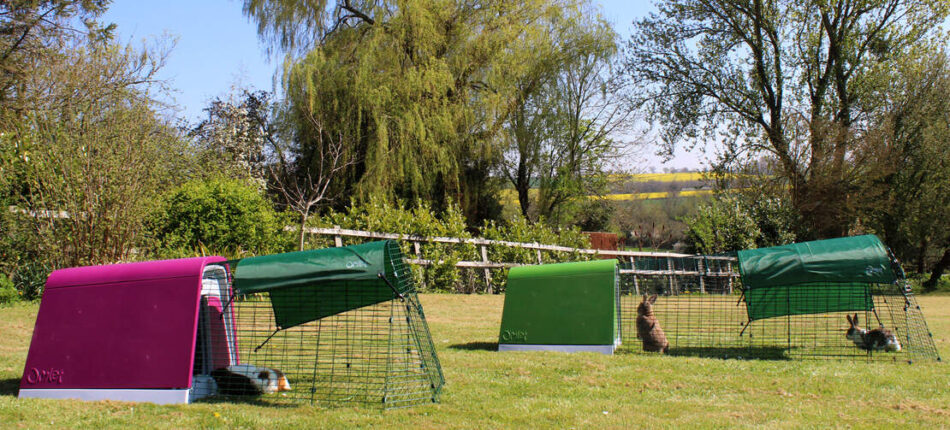
How to keep them safe if they do live together
Despite the recommendation that rabbits and guinea pigs should not house share, there may be some exceptions. Introducing them to each other when they are kittens and pups means they may grow to love one another and see each other as friends, not foes. Bringing in a new guinea pig into an environment with an older bunny could lead to a hierarchical imbalance.
You might find that they share a bond or have become the best of friends, or you simply can’t house them separately. If that is the case then there are ways you can accommodate their differences.
Create a safe space for your guinea pig
If your guinea pig needs to retreat for a moment or two then having its own space is so important. Omlet has created products that can be extended, interconnected and upgraded providing you with a simple solution when it comes to creating a unique space for your animals. Start with the Eglu Go Guinea Pig hutch which is super easy to assemble and clean. It provides that perfectly safe peaceful space for your guinea pig!
Feed your pets separately
Rather than sharing a food bowl, which we have discovered could be problematic, feed your guinea pig separately from your rabbit. Consider having a different area to feed your rabbit, like in their own enclosure.
Ensure your rabbit is neutered
Nowadays neutering small pets has become a lot safer and far more common, so it would be recommended if you plan to keep multiple rabbits or keep them with guinea pigs. Since we know that rabbits have the urge to mate constantly, this would not only be annoying for your guinea pig but it could also lead to back injuries, considering they are smaller in stature in comparison to a rabbit. By neutering your rabbit they will have less of a desire to mount their hutch-buddy!
Friendly neighbours?
Of course, there is no reason why you can’t have rabbits or guinea pigs. It is possible to create separate living areas so that they can sleep apart and have space for themselves (guinea pigs mostly), and an extensive play area (rabbits!) to keep them energised and entertained. To improve on this architectural masterpiece, provide them with a communal playpen, with an interconnecting tunnel system.
It’s not as though they can’t live together, it is possible, though it is not recommended and hopefully this article has provided enough information as to why. If you have experience of rabbits and guinea pigs living in harmony together or perhaps not, then please share your stories in the comments section below.
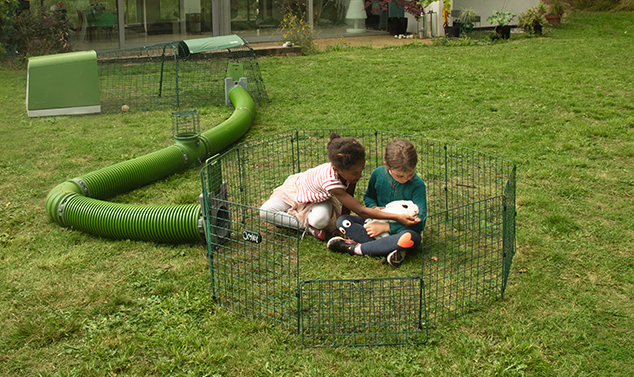
This entry was posted in Guinea Pigs
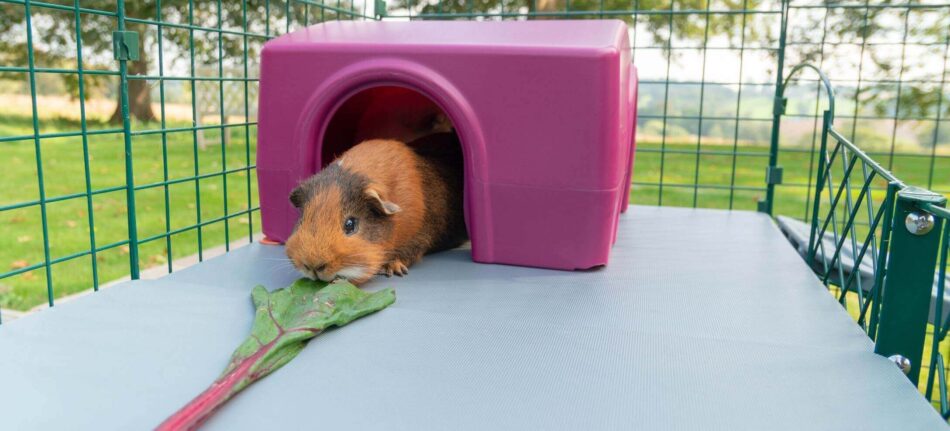
What is vitamin C, and why is it so important?
Vitamin C, also known as ascorbic acid, is an essential nutrient used to repair tissue, form collagen and keep the immune system working as it should. Something that us humans and guinea pigs have in common, which is pretty unique in the animal world, is our inability to synthesise and store vitamin C. This means that guinea pigs, just like humans, must get vitamin C from food in order to stay happy and healthy.
Luckily lots of common guinea pig food is high in vitamin C, but it’s important that you as an owner make sure that you keep track of your guinea pig’s diet so that they definitely get enough.
Is vitamin C good for guinea pigs?
Not only is it good, it’s essential for pet guinea pigs. If your pet doesn’t get enough vitamin c, they can get really ill and develop the extremely serious condition scurvy.
Signs that your pet is not getting enough vitamin c in their food includes:
- Painful joints, resulting in a change in movement or an unwillingness to move
- General lethargy and loss of appetite
- Dental and fur issues
- Haemorrhaging, which shows up as bruises on the body
If you think your guinea pig is ill, be it from lack of vitamin c or any other issue, it’s important to speak to your vet as soon as you notice any changes. Read our blog about guinea pig body language to learn more about what your pets’ behaviour could be telling you.
How much vitamin C should I give my guinea pig?
It’s generally advised to give your guinea pig between 10 and 30mg every day, however, how much vitamin C guinea pigs need varies somewhat depending on age, weight and other circumstances. Young guinea pigs who are still growing need more than the average adult cavy, and pregnant or nursing guinea pigs, or those with an underlying health condition, should get about 30 mg or in some cases more.
Most guinea pigs will get what they need from a healthy and balanced diet, but it’s good for you as an owner to know which foods to definitely include to reach the right levels.
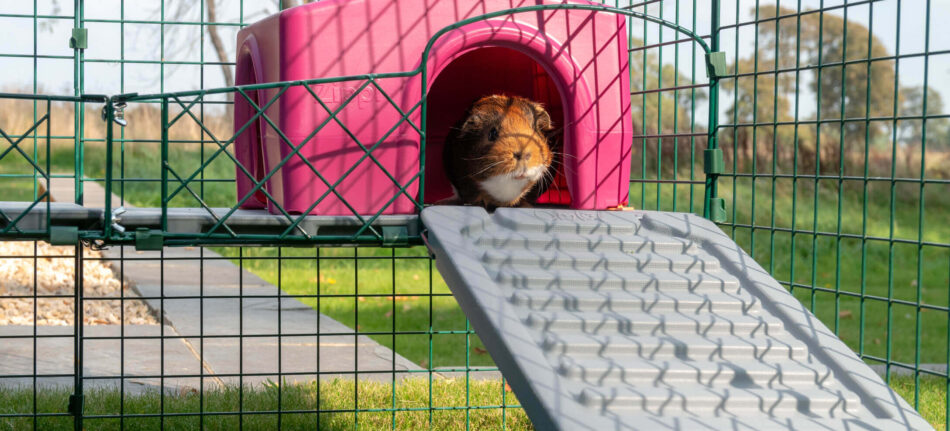
What is the best source of vitamin C for guinea pigs?
Guinea pig pellets from good quality pet shops are normally enriched with vitamin c, so a large part of your pets’ vitamin c will come from that.
Apart from the pellets, you should give your pets about a handful or two of fresh greens every day. Fresh vegetables, and leafy greens in particular, are a great source of vitamin C, and by providing them with a varied diet you can be sure that they are getting enough nutrients and vitamins.
Humans often opt for citrus when we want to boost our own vitamin C intake, but that’s not a good alternative for guinea pigs, and fruit in general is often too sweet to give on a daily basis. In fact, lots of vegetables have just as high, or even higher vitamin C content than for example oranges, including:
- Peppers
- Tomatoes
- Spinach, kale and parsley
- Broccoli and asparagus
While a good quality feed, some fresh greens and a constant supply of hay should keep your guinea pigs happy and healthy, there are other ways to boost their vitamin intake. This is particularly helpful if you’ve got a pet who is ill and struggling to eat, or if you for one reason or another don’t have access to fresh vegetables. Some of these include:
- A supplement vitamin C tablet
- Liquid vitamin C
- Vitamin C enriched treats
Make sure what you’re giving your pet is specifically designed for guinea pigs, and always read the label to make sure you’re giving the right dose. You might even want to ask your vet before you start giving supplements regularly.
Avoid water-based vitamin C drops. Once in the drinking water, the concentration is very low, so your pet will have to drink a lot to get any benefits. What’s more is that it can make the water taste different, which can instead turn your pet off their water, which is even more of a worry.
What happens if a guinea pig gets too much vitamin C?
If your pet occasionally consumes more vitamin C than the recommended daily dose, that’s nothing to worry about, as any excess vitamin C the body doesn’t need will come out with the urine. In general it’s difficult for a guinea pig to overdose on vitamins, but if they regularly get more than 30mg it can result in serious health issues, for example a condition called pseudo-scurvy, a reduced sensitivity to the vitamin.
Too much vitamin over a long period can cause bladder and kidney stones, and can halter healthy development for growing guinea pigs.
If you’re feeding your guinea pig a balanced diet with good quality guinea pig pellets you generally don’t have to worry about this, it’s more of a problem if you’re providing additional vitamin C in the form of supplements.
Other important vitamin C information
It’s good to know that even if you’re doing what you can to provide your guinea pig with everything they need, they can still get a vitamin c deficiency. Often this has got to do with out of date or badly stored food. Vitamin C has a sell-by date, and the nutritional content decreases as the food gets older.
This applies to fresh fruit and veg, as well as store bought pellets and vitamin C supplements, so make sure you always keep your guinea pigs food fresh and stored in the right way. Get rid of anything that is out of date, and never give your pets mouldy or otherwise gone over greens.
This entry was posted in Guinea Pigs
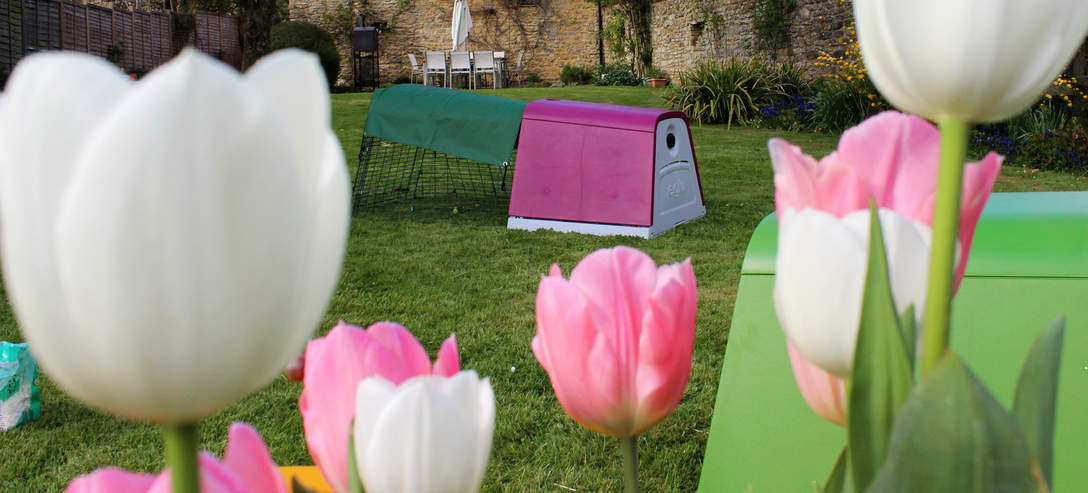 Spring has nearly sprung, which of course means new beginnings! Many of us will make a start to the annual spring clean and take advantage of the slightly longer days and warmer weather by spending some more quality time outdoors again. And just like us, our pets appreciate all that spring has to offer after a long winter! For our furry friends, this season means more time outside in their run, where there will now be a lot less mud, and plenty of luscious grass to play in and peck at. But before your pets head out again, get them involved with the spring clean and give their run a tidy up as well!
Spring has nearly sprung, which of course means new beginnings! Many of us will make a start to the annual spring clean and take advantage of the slightly longer days and warmer weather by spending some more quality time outdoors again. And just like us, our pets appreciate all that spring has to offer after a long winter! For our furry friends, this season means more time outside in their run, where there will now be a lot less mud, and plenty of luscious grass to play in and peck at. But before your pets head out again, get them involved with the spring clean and give their run a tidy up as well!
Move Runs to a Fresh Space
Before beginning a spring clean, you’ll want to take your chickens, guinea pigs, or rabbits to a temporary enclosure to keep them safe and out of the way. Once this is done, you can move their run to a fresh spot in the garden. All Omlet runs can be transported and can then simply be secured in their new position using the Omlet screw pegs.
As we’ll now (hopefully!) have a bit more sun, place your run in an area where your pets will have plenty of room to explore. When we head later into the season, it’s a good idea to purchase some weather protection for your run, which will keep your animals shaded from the sunlight.
Change Their Bedding
Guinea pig and rabbit bedding should be changed frequently (twice a week), so be sure to include this job when you’re carrying out the spring clean. Fortunately, the Omlet rabbit hutches and guinea pig hutches can be easily navigated to change bedding with slide-out trays, which can be cleaned and refilled.
For hens, spring is the time of year where you’ll begin to notice an increase in egg laying output after a winter of minimal or reduced egg production. Make sure that your hens’ nesting boxes have soft bedding for chickens, which will provide them with a cosy place to nest, as well as reducing odours in their coop.
Use Caddis to Improve Run Cleanliness
To further improve cleanliness of your rabbit or guinea pig hutch, you can use Caddis as an alternative way of feeding. Not only do Caddi Treat Holders provide pets with the mental stimulation they require but they keep food off of the run floor. In doing so, you’ll also keep unwanted predators and rodents away from your pets.
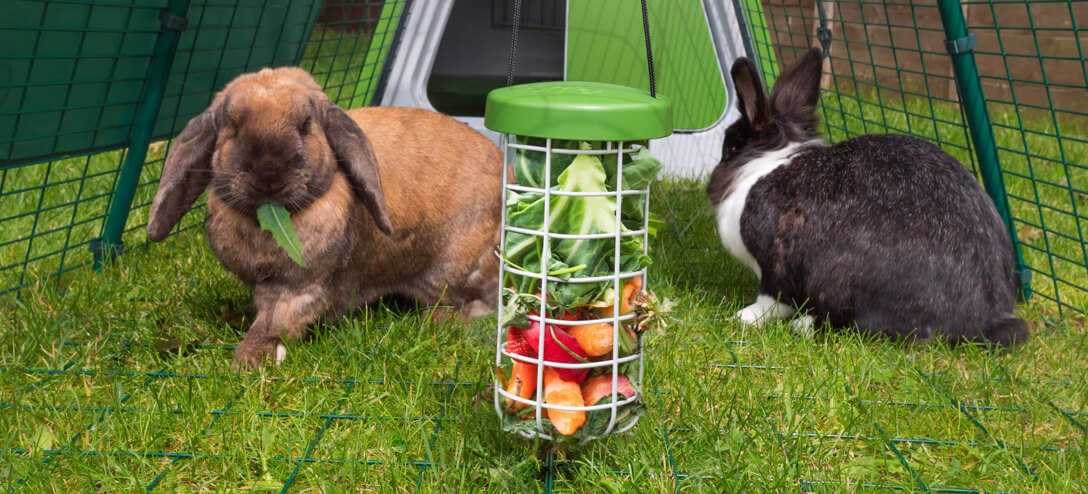
Give Your Pets a Groom
As well as keeping your pets in pristine condition, grooming is a great way to build a bond, and it’s not just for cats and dogs! So why not hop into the new season with your pet looking their very best, all ready to get back into their run?
Although it might be your first instinct to run your guinea pig a bath if they’re looking in need of a clean, this can actually be harmful for them. Instead, invest in a guinea pig grooming kit and chemical-free wipes, which will help to maintain their fur cleanliness. For more information on guinea pig hygiene, have a read of a previous blog we wrote on this topic.
The amount of grooming a rabbit needs, however, is dependent on its breed. Longer haired breeds such as the Lionhead require a thorough grooming regime, so it’s important that you upkeep this routine all year round.
Chickens are very low maintenance animals, and will often bathe themselves in dust to keep clean. You can even offer them a helping hand and make your very own chicken dust bath by converting a bucket or old cat litter tray!
Extend Their Run
Now that your spring clean is complete, why not consider adding a few extras to their run? Your pets will be spending more time outside, so it’s the perfect excuse to get an extension for their run, and the Zippi Run Extension Kits are ideal for making your rabbit or guinea pigs’ play space bigger. For chickens, try the Chicken Walk In Run Extensions, which can be fitted to your existing chicken run to give your flock some extra freedom.
Upgrade Your Pets’ Run With New Toys and Accessories
A few more toys and accessories for your pets’ run won’t go amiss either! Omlet has a wide range for chickens, guinea pigs, and rabbits. The Zippi Shelter with a Play Tunnel is a great option to go for, giving your cavies hours of entertainment in their run, alongside providing them with plenty of exercise, essential for their wellbeing.
Chickens will absolutely love the Omlet Chicken Peck Toy for their run, which can be filled with their favourite treats or feed, stimulating their foraging instinct.
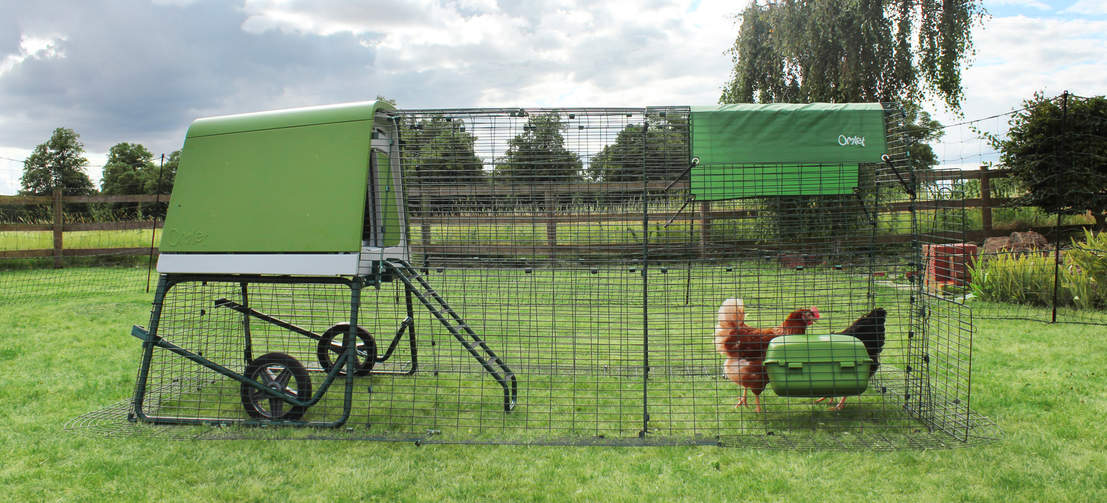
Now you’re hopefully all ready for what spring brings you and your pet. Make a start to upgrading their run today!
This entry was posted in Chickens
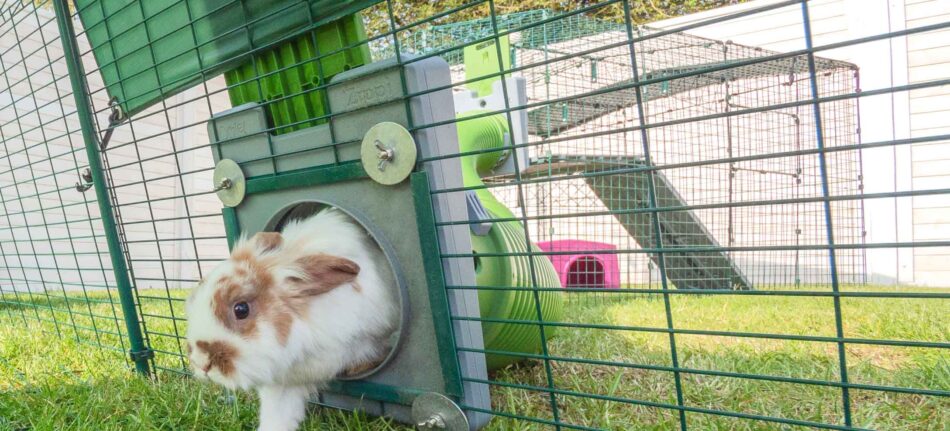
Providing your small pets with enough exercise and activity is extremely important for their mental and physical well-being. An under stimulated rabbit or guinea pig will easily become bored, which can result in unwanted behaviours and a lot of frustration. Luckily, there are things you as an owner can do to encourage movement and introduce more excitement into their lives. Here are some of our top tips:
Provide more space
It might seem obvious, but it’s much easier for a rabbit or guinea pig to get enough exercise if they have plenty of space to move around on. Extend their current small animal run, add new small animal playpens, or set up a room in the house or area of the garden where your pets can securely roam free.
Change things up
New things will excite and stimulate your rabbits and guinea pigs. However, they don’t need a completely new home every month to stay interested. Regularly swapping toys around or changing the setup of their hutch and run by moving accessories to new places will encourage them to explore, stimulating both brain and body!
Get them foraging
Rabbits and guinea pigs instinctively love searching for food. You can help them live out this natural interest by hiding treats in their enclosure, stuffing hay into small nooks or putting leaves, fruit and vegetables in a Caddi Guinea Pig or Rabbit Treat Holder. Anything that gets your pets working for the reward of some really good treats is great in terms of activating them!
Level up
Adding guinea pig and rabbit platforms to your enclosure is a great way of utilising all the space available. Guinea pigs will love running down ramps, and rabbits can use their long leg muscles to jump up onto platforms or steps. As if that wasn’t enough, rabbits especially love sitting up high and inspecting their surroundings, so giving them a lookout space is going to be very popular!
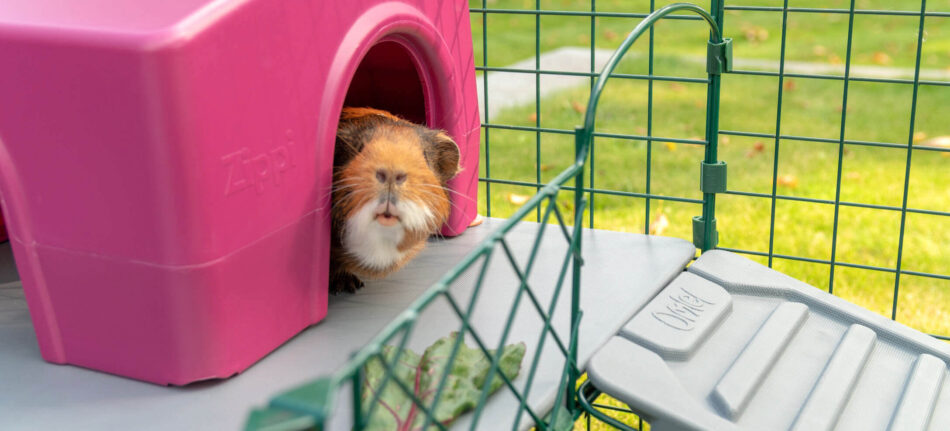
Digging opportunities
While it might not apply to the average guinea pig, you will struggle to find a rabbit that doesn’t absolutely love digging. If you don’t want them to ruin the lawn, giving them a designated digging pit is a good idea. A large plant pot or tray with loose soil will be a great start. You can also put some crumpled up newspaper in the bottom for your rabbit to shred.
Get involved with the playing
If your pet is comfortable with it, a great way of activating them is to play together. Get down to their level and give them some time to get used to your presence. Eventually they will likely approach you and you can slowly introduce games and interactive playing. You can bring toys and treats for encouragement, depending on what your pet likes.
Some rabbits and guinea pigs can also be mentally stimulated by learning tricks. We’ve got a blog on how to train your small pet if you think this might be for you!
Teeth exercise
Rabbits’ and guinea pigs’ teeth never stop growing, so to keep them in tip top shape your pets will need something to grind them down with. A constant supply of hay is the most important thing, but you can also give them gnaw toys and pet friendly branches to nibble on.
Give them a space to rest
While it’s important to give your pets enough space and opportunities to move and exercise, it’s just as important to make sure they have places in their home where they can settle down and relax. Being prey animals, they will benefit from having somewhere secluded to return to where they know they will be safe. This could be snuggling down in the bedding of their rabbit hutch, or peeking out from a guinea pig shelter on the run.
This entry was posted in Guinea Pigs
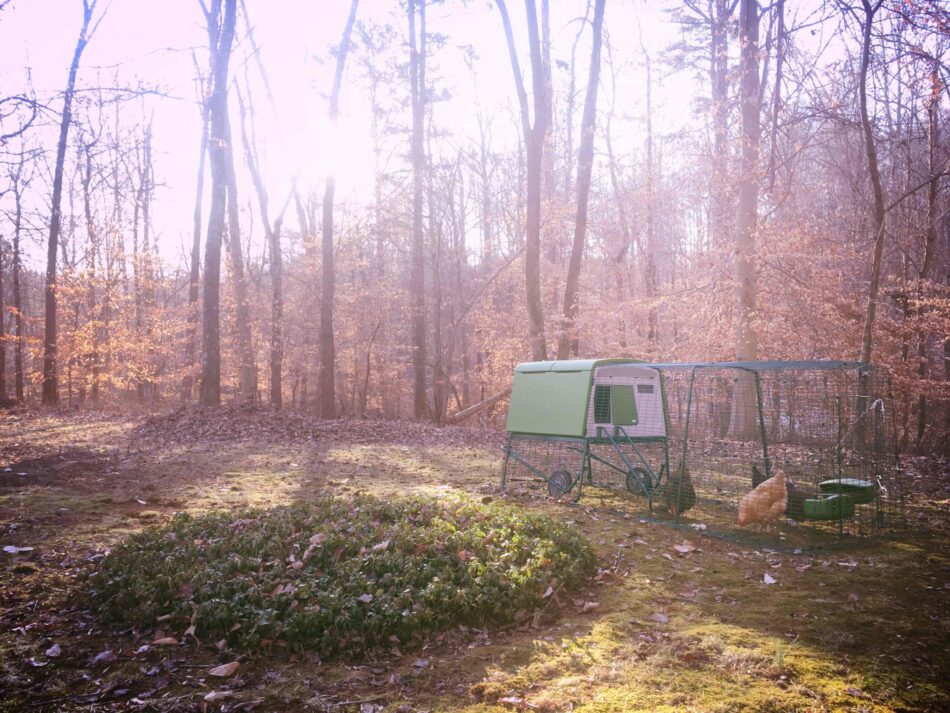
It’s that time of year again when we say goodbye to summer and welcome in the cooler, shorter autumnal days. For many pet owners, summer is a great opportunity to spend quality time with their animals; playing outdoors and enjoying the warmer weather. But, the change in season doesn’t have to mean that the good times have to stop. So whether you’ve got a chicken, guinea pig or are a pet parent to rabbits, here are 8 tips for making their run more fun this autumn.
Why do pets need runs?
It’s important that you continue to keep your pets exercised throughout the year, and animal runs are great for this, giving your furry friends the freedom to roam within a safe and confined environment. Omlet has a range of runs for chickens, rabbit runs and guinea pig runs, which are all predator-resistant, with their innovative mesh designs.
Whilst runs are fantastic for providing your animals with more space, adding a few extras over the next coming months can help to keep both you and your pets entertained.
For guinea pig and rabbit runs
Pig out on veggies
Cavies and rabbits love their fresh veg – you can even make a game of it! Try hiding their favourite pieces of veggies around the run and have them go off to find their treats. This game is the perfect opportunity for you to spend some quality time outside with your pet. Just don’t forget to clean up any remains from the run floor to avoid pesky predators sniffing out the snacks.
Or, use the Omlet Caddi rabbit treat holder or guinea pig treat holder to keep your pets’ brains engaged. Simply fill the treat holders with your rabbit or guinea pig-safe vegetables and watch them spend time navigating how to get them out. Take a look at some suggestions for rabbit treats and guinea pig treats here.
DIY adventure playground
Upgrade your pets’ run to an adventure playground with pet play tunnels. They can simply be attached to your guinea pig or rabbits’ run and provide them with a new way to exercise. Plus, they’ve been designed to mimic the innate burrowing behaviours of rabbits and guinea pigs too.
Shelters can also be a great addition to your run this season. The Omlet Zippi Shelters for rabbits and Zippi Shelters for guinea pigs are weatherproof too, meaning that your pet will be protected from the elements in autumn.
And since both pets have a natural desire to seek a hiding space in a hole, you can be assured that while they’re having fun, they’re feeling safe. The Zippi shelters easily attach to the Omlet play tunnels via connector rings, too, which means you can create a fun maze for your furry friends.
Guinea pig and rabbit toys
Who said toys were just for cats and dogs? Give a new toy to your small animal to help to bust their boredom this season. Toys for guinea pigs and rabbits can simply be hung up in their run and will keep them active, engaged, and curious.
For chicken runs
Make use of those crisp, autumn leaves
The leaves of autumn in your garden can actually be a great source of entertainment for your chickens. All you have to do is build up a pile of crisp autumn leaves in your chickens’ run, and watch them have endless hours of fun pecking. You can even add some sunflower seeds to your pile to have your flock hunt for.
Omlet’s Chicken Swing
Omlet’s Chicken Swing is the perfect way to make your chickens’ run more fun this autumn. The Omlet Chicken Swing will have your chicken in their element, as they get to grips with their new toy. Not only will this run accessory provide them with plenty of entertainment, but you’ll have just as much fun watching them hop on and off and swing back and forth.
Toys for chooks
Chickens can have toys too. A bored chicken can lead to behaviour such as flock bullying and abnormal feather loss, so at this time of year it’s even more important to keep your chickens entertained. Naturally, as the weather drops, these animals get increasingly restless, with less grass and weeds for them to forage on, as they enjoyed over the summer. A chicken peck toy though, is one option to keep your flock happy, providing them with physical and mental stimulation.
Omlet and your pets’ autumn
Omlet knows that this time of year can be more difficult for pet owners but whatever the season brings this year, with Omlet’s range of guinea pig, rabbit and chicken products you and your pets can continue to have fun all autumn long. And, as the end of the season brings colder weather, don’t forget to have a read of the Omlet guides on keeping your guinea pigs, rabbits, and chickens safe and warm when they’re outdoors.
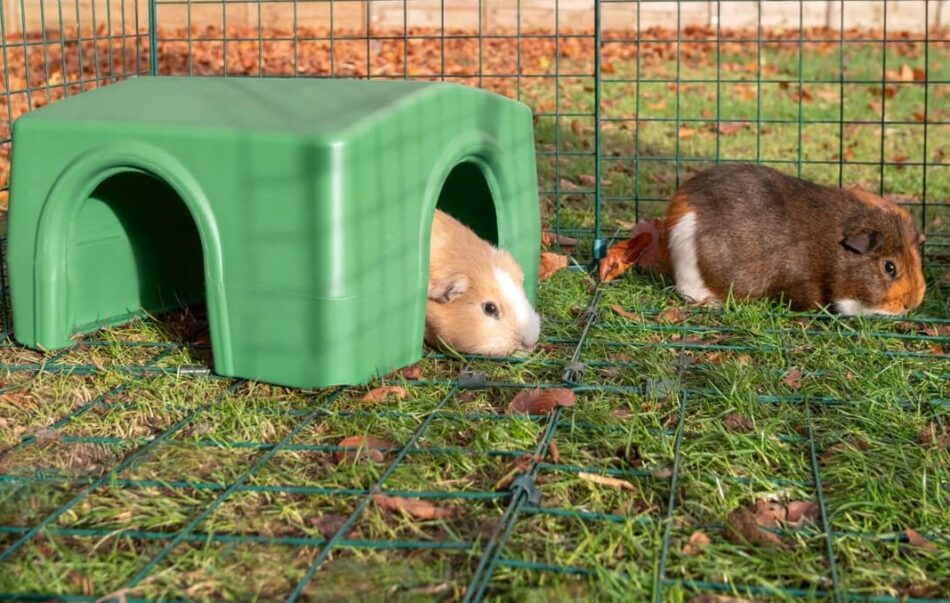
This entry was posted in Chickens
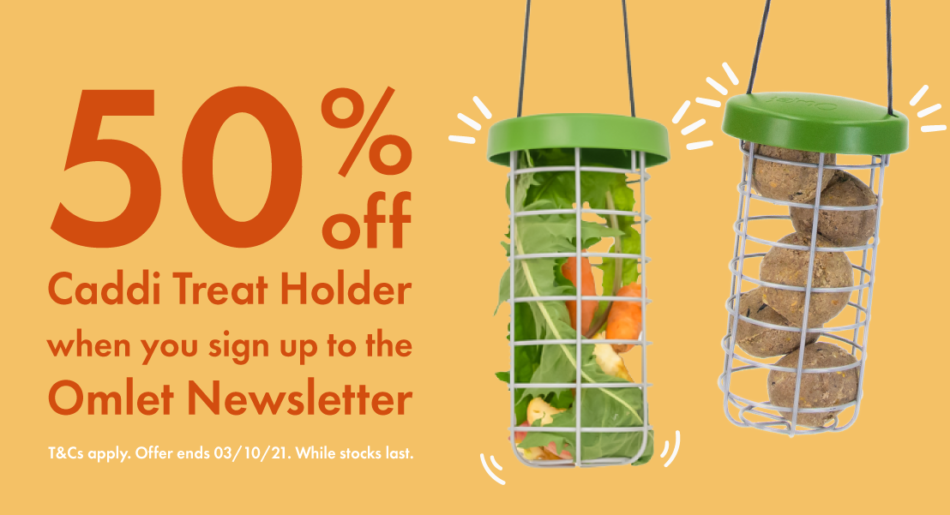
Ever cleaned your pets’ run and found old bits of mouldy cabbage or soggy feed that is nearly impossible to pick out of the grass? There is an easy way of keeping your pets’ treats fresh for longer, while also improving run cleanliness AND keeping your animals entertained!
The Caddi can be hung at any height from all pet runs, trees or other structures in your garden. It’s super easy to fill with whatever you want to give your pets, be it bits of fruit, fresh hay or Feldy Chicken Pecker Balls.
At the moment you will get 50% off Caddi Treat Holders for chickens, rabbits and guinea pigs when you sign up to the Omlet newsletter. Take this opportunity to make your pets’ run funner and more hygienic than ever before!
4 reasons Caddi will improve your pets’ run:
All pets will be happier if their living quarters are tidy and clean, but it’s also important for their health that both their coop or hutch and run are kept hygienic. Mouldy food left on the damp ground can make a chicken, rabbit or guinea pig very ill, so having a Caddi to keep it in will make it much easier for you to spot anything that’s gone off, and to remove it in a second.
Food, treats or hay that is left on the ground on the run will go off very quickly, especially at this time of year when temperatures can vary dramatically between day and night and there is likely to be more rainy days. With the Caddi, the treats you leave your pets will keep fresher for longer as they won’t come into contact with the wet ground. They will also be kept dryer thanks to the waterproof top.
The end of summer means that there will be less food available for wild animals like rodents and small birds, and they are likely to approach your garden and your pets’ home in search for tasty morsels. By putting feed, hay or vegetables in the Caddi rather than scattering on the ground, you are making things more difficult for uninvited visitors!
As the treats, veg or hay you are giving your pets are kept contained in one place and won’t get stepped on by muddy feet, they will be crunchier, cleaner and better tasting. As the swinging motion of the Caddi offers stimulation and entertainment, your pets will truly enjoy snacktime!

Buy now and get 50% off when you sign up for the Omlet newsletter!
Terms and conditions:
This promotion is only valid from 28/09/21 – midnight on 03/10/21. Once you have entered your email address on the website you will receive a discount code that can be used at checkout. By entering your email you agree to receive the Omlet Newsletter. You can unsubscribe at any point. This offer is available on single Caddi Treat Holders only. The offer does not apply to Twin Packs, Twin Pack with Peck Toys or packs with Feldy Chicken Pecker Balls. Excludes all other chicken accessories. Offer is limited to 2 Caddis per household. Subject to availability. Omlet ltd. reserves the right to withdraw the offer at any point. Offer cannot be used on delivery, existing discounts or in conjunction with any other offer.
This entry was posted in Chickens
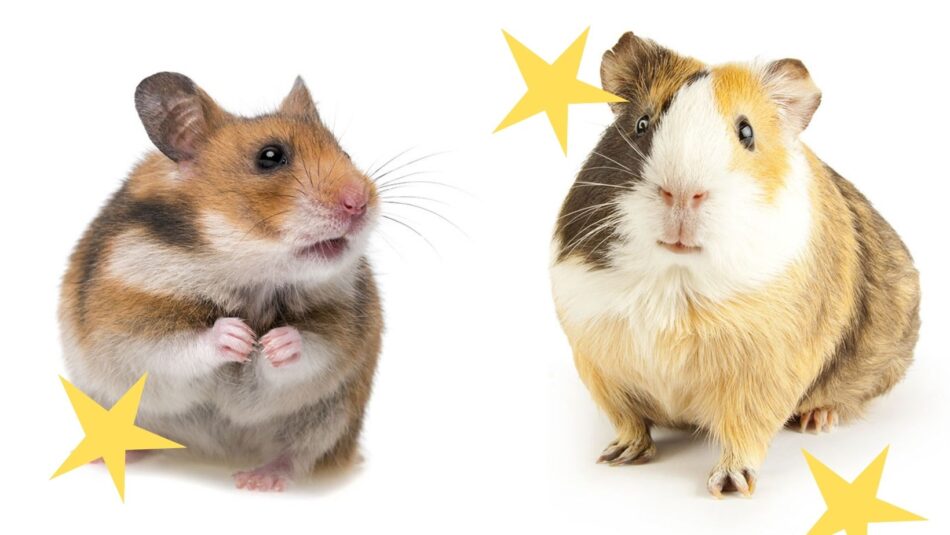
Hamsters and guinea pigs are relatively low maintenance pets that make a great choice for new pet owners. The two animals have several fundamental differences, though. Knowing what these differences are will help you make the right choice when choosing your pet.
Wild hamsters live across large areas of Europe and Asia, notably in Syria, China and Russia, which are the ancestral homes of most hamsters kept today as pets. These little rodents prefer dry, warm climates.
Guinea pigs are native to the mountainous regions of South America – Colombia, Ecuador, Peru and Bolivia. However, they belong to the same broad family as hamsters – the rodents. This kinship is a bit misleading, though, as the animals have distinctly different needs and dietary requirements.
Hamster vs Guinea Pig
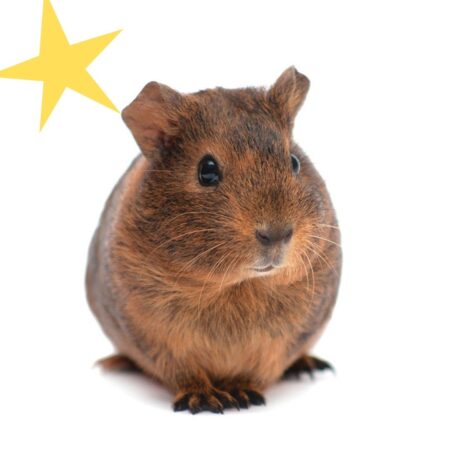 While these two critters do have things in common, their different habitats and ways of life mean that a hamster’s home setup is very different from that of a guinea pig.
While these two critters do have things in common, their different habitats and ways of life mean that a hamster’s home setup is very different from that of a guinea pig.
One major thing that differentiates hamsters and guinea pigs is lifespan. Hamsters have shorter lifespans than guinea pigs, generally living for 2 to 4 years. This is because they are small and have metabolisms that work much faster than their guinea pig cousins. Guineas generally live from 5 to 8 years, with some individuals reaching 10 years.
Another key difference between the two is their size. As we mentioned above, hamsters are much smaller than guinea pigs, with the average size being in the region of 5-15cm. Even the smallest guinea pigs are larger than the biggest hamsters, with the average guinea being 20-30cm long. This means that guinea pigs need larger enclosures.
While the size of the animal and its enclosure needs to be considered, these factors don’t have a huge impact on general pet care. The following differences are the ones that need to influence your decision.
The four main differences between hamsters and guinea pigs
1. Sleeping patterns
This is possibly the biggest difference between the two species. Hamsters are generally nocturnal creatures, which means they prefer the nightlife. Many hamster owners will be able to tell you how their hamster starts running in its squeaky wheel at 1am!
Guinea pigs, on the other hand, are mostly active during the day, taking naps whenever they feel the need. Rather than sleeping for one long spell each day, they recharge their batteries whenever they feel like it. They do tend to sleep more during the night, though.
2. Social needs
Hamsters and guinea pigs have completely different social needs. In the wild, guinea pigs live in groups of three to ten individuals. They have evolved to be social animals and will soon become sad and stressed if they are denied this interaction. Lonely guinea pigs have even been known to die when left in isolation for too long.
For this reason, it is highly recommended that owners should keep at least two guinea pigs. Keeping just one can work as long as someone is willing and able to step in and do the socialising. Because of their need to be with other animals, guinea pigs will be much more willing than hamsters to spend time, play and interact with humans. This factor – and their handy habit of sleeping at night – can make them the superior choice for children who want to play with their pets.
Hamsters are loners. That, at least, is the case with the Syrian or Golden hamster, which is by far the most popular pet hamster species. While they can live with companions, the other hamster species are perfectly happy – and may in fact be even happier – living on their own. Many hamsters that are kept together can become aggressive towards one another, especially if two males are being kept in close quarters.
If looked after properly and hand-tamed from an early age, hamsters will form a bond with their owners and will be glad to spend time with them. An unsocialised hamster will often bite, though, and this is another offputting thing for children.
3. Diet
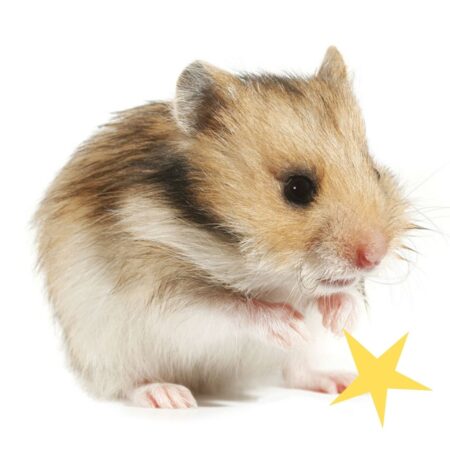 The dietary requirements of hamsters and guinea pigs are probably the most significant difference between the two species. Hamsters are omnivorous and will eat pretty much anything they can find. They famously store food in their cheeks for later, making their cute faces puff up, almost doubling the animal’s size.
The dietary requirements of hamsters and guinea pigs are probably the most significant difference between the two species. Hamsters are omnivorous and will eat pretty much anything they can find. They famously store food in their cheeks for later, making their cute faces puff up, almost doubling the animal’s size.
The easiest option for feeding a hamster is to buy a pre-made food mix that has all the things they need, rather than sourcing your own insects and extra protein to supplement the plants and vegetables in their diets. You can feed your hamster fresh fruit and vegetables, as long as they are washed, and as long as they don’t completely replace the hamster mix. Grains and cereals make a good addition to their diets, too. Also, be sure to provide your hamster with something to chew on, such as a piece of wood or some straw, as this helps keep their teeth in check.
Unlike hamsters, guinea pigs are vegetarian. In the wild, they eat fruits, plant roots and – most importantly – lots of high-fibre grasses. As with hamsters, domestic guinea pigs should be fed a specially made food mix. However, these often have lots of carbohydrates and not enough fibre. For this reason, your guinea pigs will also need lots of fresh vegetables, fruits, grass and hay alongside their food mixes. Hay is crucial for keeping the guinea pigs’ teeth in check, and it also ensures a healthy balance in the stomach bacteria the animals need for digesting their food efficiently.
4. Space
Hamsters are always kept indoors, as they need to be kept somewhere consistently warm. Being small creatures, they don’t need a huge amount of living space, and an enclosure such as the Qute can be incorporated into a room as an attractive part of the furniture as long as they are taken out of the cage for daily exercise and play.
Guinea pigs, in contrast, need a larger hutch and a run, as they are not only bigger than hamsters but need to be kept in groups. Some are kept indoors throughout the year, but if you have space for a guinea pig run in the garden, the animals will love it, and children will be able to interact with their pets in the most effective way.
The upshot here is that a hamster can be easily accommodated if you only have a small indoor space, but a guinea pig can’t.
Overall, both hamsters and guinea pigs make great pets, and both are low maintenance. The key differences between the two are size, lifespan and diet. When choosing which of these wonderful little animals to keep, it mainly boils down to personal preference. As long as you care for them properly, they will soon form a close bond with you.
This entry was posted in Guinea Pigs
Keeping your pets and their homes clean and hygienic is one of the best ways to prevent illness or distress. It’s obvious when your guinea pig is happy and in good health, as they will be running, playing, chattering and acting as they usually do. However, if your guinea pig seems to be under the weather, but a trip to the vet has identified no underlying problems, this could be a sign that better hygiene is required. Here are 5 guinea pig care tips, so that you can be on your way to helping your cavies!
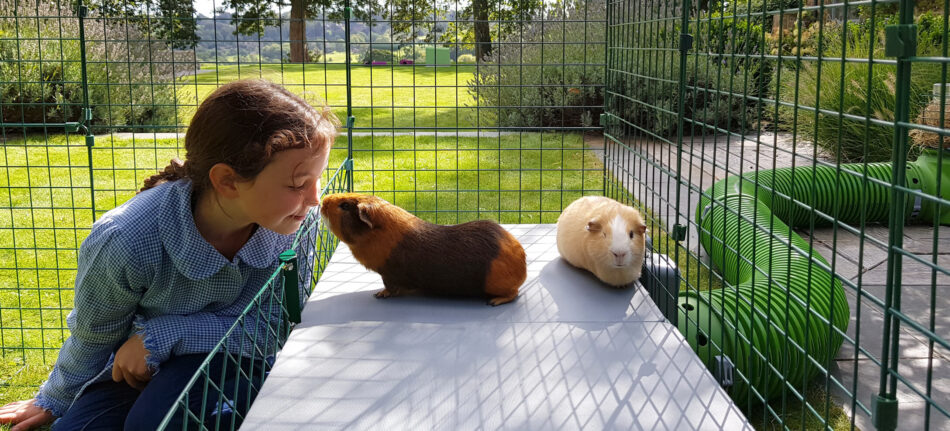
1. Avoid frequent bath time!
If your guinea pigs’ coats are in need of a good clean, there are some important things to bear in mind. Whilst it might be your first instinct to want to bathe them, this can actually be bad for your guinea pigs’ health. In particular, this can lead to developing dry skin.
Guinea pigs actually maintain a good level of cleanliness through self or group-grooming naturally. If a guinea pig coat becomes matted with dirt, you may need to use a chemical-free wipe to slightly wet the fur, enabling you to clean it thoroughly. If a guinea pig’s coat gets wet in the process of cleaning, make sure they have plenty of blankets and warm toys to surround themselves with afterwards.
However, it’s still a good idea to invest in a grooming kit, especially if your guinea pig lives alone. Therefore, you can take the place of their fellow guinea pigs in maintaining their lovely coats!
2. Keep on top of dental hygiene
If you notice that your guinea pigs’ teeth have grown very long, or they’re having trouble eating, it’s a good idea to check with your vet if any action needs to be taken. You can read more about taking care of guinea pigs’ teeth in this Omlet guide.
3. Trim your guinea pigs’ nails
Similarly, you should keep an eye on your guinea pigs’ toenails. Guinea pig toenails need cutting regularly, to keep up with their care regime. If their nails are white, then it is easier to see the blood vessel, or the quick, running down the centre of their nails. This way, you can trim the tip of the nail and avoid the quick. With darker nails however, it can be more difficult to see this. If in doubt, contact your vet, who will be able to help you out with this procedure.
4. Regularly clean your guinea pigs’ hutch
You may be wondering how to clean a guinea pig’s cage, but it’s pretty simple (especially if you have an Eglu Go Guinea Pig Cage!).
Plastic hutches
A healthy guinea pig is a relatively clean animal that relies heavily on the nature and safety of their habitat. The cage, hutch and enclosure are the best places to start when looking at ways to improve your pets’ environment. Depending on the material your enclosure is made of, you will need specific products to clean it. Using the right sort of cleaner will ensure you get the most out of every home and piece of play equipment you buy for your guinea pig.
If your guinea pigs live in a cage or caged hutch, a pet-safe liquid spray disinfectant is perfect for cleaning the cage and any plastic base or guinea pig play equipment. It’s a good idea to soak the cage in water and let it dry before disinfecting, as this will loosen any large pieces of dirt and allow the spray to do its job! If regular disinfecting isn’t doing the trick and the hutch retains unpleasant odours, try using hutch cleaning granules, which have been specifically designed to eliminate smells from your pet’s home. When it comes to how often you should clean a guinea pig cage, the rule of thumb is that it should be done on a twice-weekly basis. This involves taking all of their bedding out of their sleeping area, emptying and cleaning their food bowl, cleaning their feeding area, replacing all the bedding and replenishing the food. The more guinea pigs you have the more often this will need to be done, as more excretions will be produced and more mess made.
Wooden hutches
If your guinea pigs live in a wooden hutch, you need to disinfect it as you would with a regular cage, and it’s also a good idea to clean it every month or so with hot soapy water and scrub the wooden surfaces. Try to minimize soaking the wood by squeezing out most of the water from your sponge before cleaning. If the hutch contains any fleece liners, these are usually machine washable, and it’s good practice to give them a clean more regularly than you would the rest of the hutch. Regardless of which type of hutch you use, always let it dry thoroughly after cleaning before reintroducing the guinea pigs.
5. Replace your guinea pigs’ equipment
Everything you buy for your guinea pigs has a different lifespan, but it is often a good idea to replace items before they deteriorate completely. A typical pet’s water bottle could last many years without breaking, but replacing it every year or so is a good idea. This is because repeated wear and tear of the plastic bottles can result in the animals ingesting plastic, in small pieces or as micro-plastics in the water itself.
Likewise, if you feel that any piece of equipment is no longer possible to fully clean, even after a thorough attempt, it is a good idea to replace it. Your pet would appreciate having something new to play with. Check out Omlet’s range of guinea pig run accessories that are bound to keep your cavies thoroughly entertained!
Although there is no way to ensure your guinea pigs will always stay healthy, paying attention to their hygiene and nutrition will set your pets up for long and healthy lives. Doing plenty of research on your guinea pigs is one of the best things you can do as a pet owner. For example, guinea pigs need lots of vitamin C, and they have been known to lack this essential nutrient in their diets. We’ve even written about why vitamin C is so Important for guinea pigs in a previous blog. They will benefit from the occasional use of supplements.
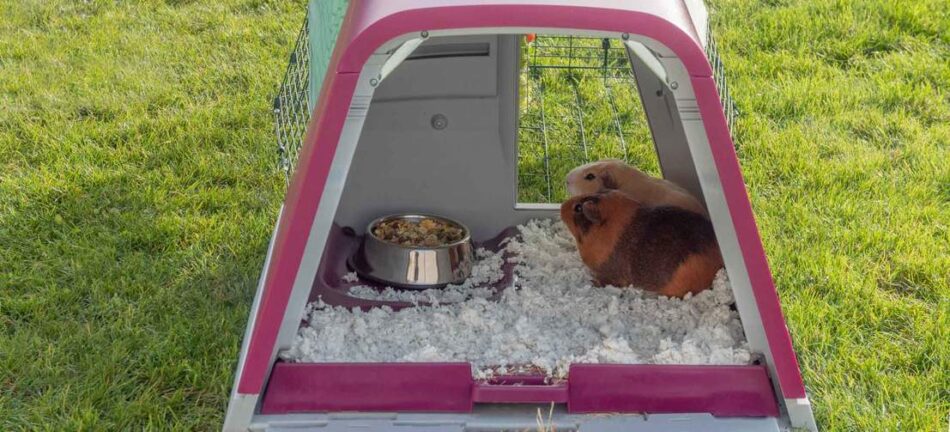
Keeping up to date with the latest advice on guinea pig health has never been easier than on the Omlet Blog, so be sure to keep checking back in for new articles! You can also visit the Omlet website. Where you’ll find guinea pig run accessories, feeders, and hutches that your pets will love!
This entry was posted in Guinea Pigs
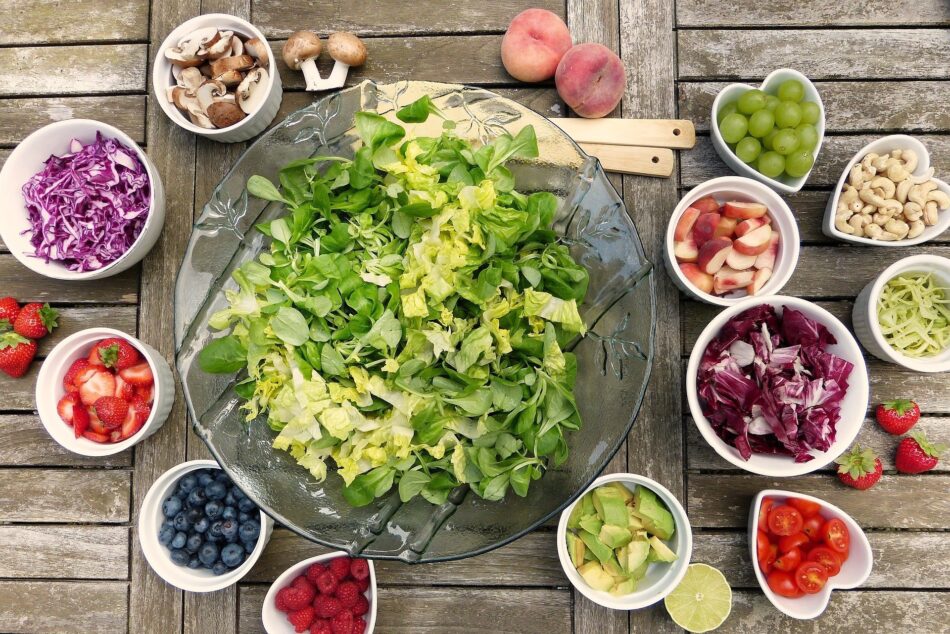
Some pets, including rabbits and guinea pigs, are naturally vegan. Hamsters and gerbils, although omnivorous, can thrive on a vegan diet in which the protein content is supplied by plants and vegetables. Others, including omnivorous dogs and out-and-out carnivore cats, cannot be easily pleased on meat-free diets.
All animals need to have their nutritional needs satisfied. But this does not mean you can’t have a vegan dog. Vegan cats, though, are a lot trickier.
Can my dog have a vegan diet?
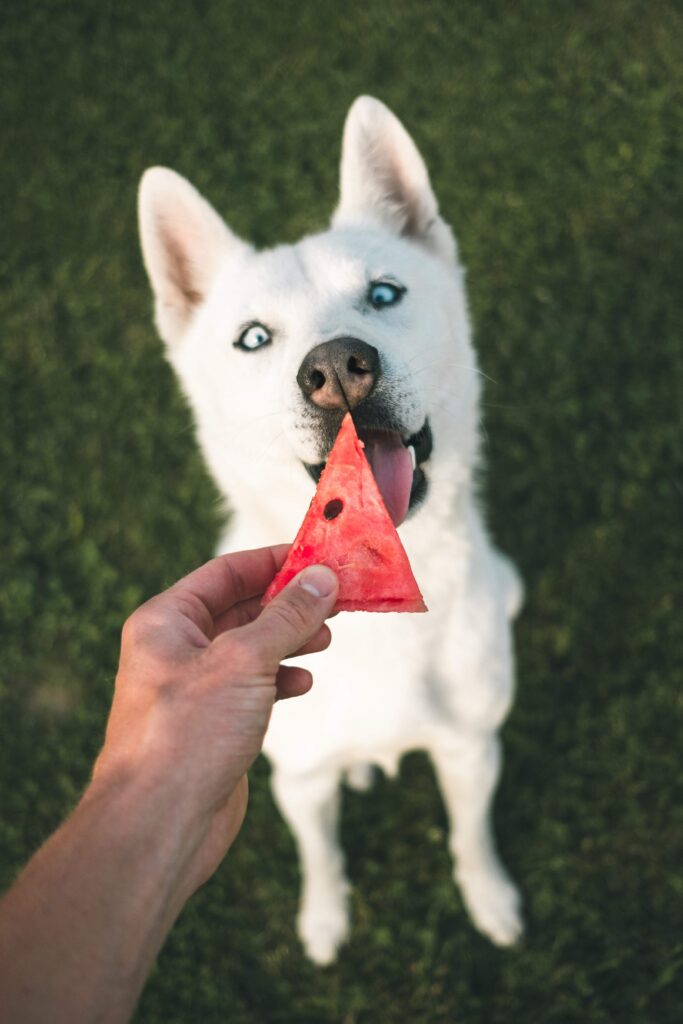 If you were to meet a species of animal for the first time and had to make an accurate guess about its diet, you would get lots of clues by looking at its teeth. The teeth of a dog, like the teeth of a bear, proclaim loud and clear that this animal is an omnivore – that is, one that eats both meat and vegetables. If you think of your dog as a domesticated wolf, you get a good idea of its natural diet.
If you were to meet a species of animal for the first time and had to make an accurate guess about its diet, you would get lots of clues by looking at its teeth. The teeth of a dog, like the teeth of a bear, proclaim loud and clear that this animal is an omnivore – that is, one that eats both meat and vegetables. If you think of your dog as a domesticated wolf, you get a good idea of its natural diet.
However, as the panda proves, a supposed meat-eater can sometimes get by perfectly well on a vegan diet. A panda’s teeth are similar to any other bear’s – long canines for meat-eating and molars for grinding vegetation. And yet pandas don’t eat anything other than bamboo. So, if a bear can be vegan, does that mean you can have a vegan dog?
The answer is yes – but it’s a yes with lots of small print! A dog requires a diet that contains the fats and proteins it would get from meat. It is dangerous to ignore this basic need and simply feed your pet with whatever you please. Some dogs have delicate stomachs at the best of times, and a low-fat, high-fibre diet can cause potentially life-threatening problems. A diet that excludes meat should never be fed to a dog without the advice of a professional pet dietician.
The collagen, elastin and keratin found in meat diets are not easily replaced by vegi equivalents. Your dog will also need the ‘long chain’ omega-3 fats found in animal products such as egg, fish and some meats. Vegan omega-3 fats are not the same as animal-derived ones.
All of which presents a headache for the vegan dog owner. There are, however, products available that claim to let your dog live a healthy, meat-free life. Before you take the plunge, it is essential to seek professional, scientific advice and guidance. Compromise is usually the best choice here – a vegan diet supplemented by some of the animal-derived essentials. Crickets, for example, can provide lots of the amino acids and keratin a vegan diet lacks, and they’re 65% protein.
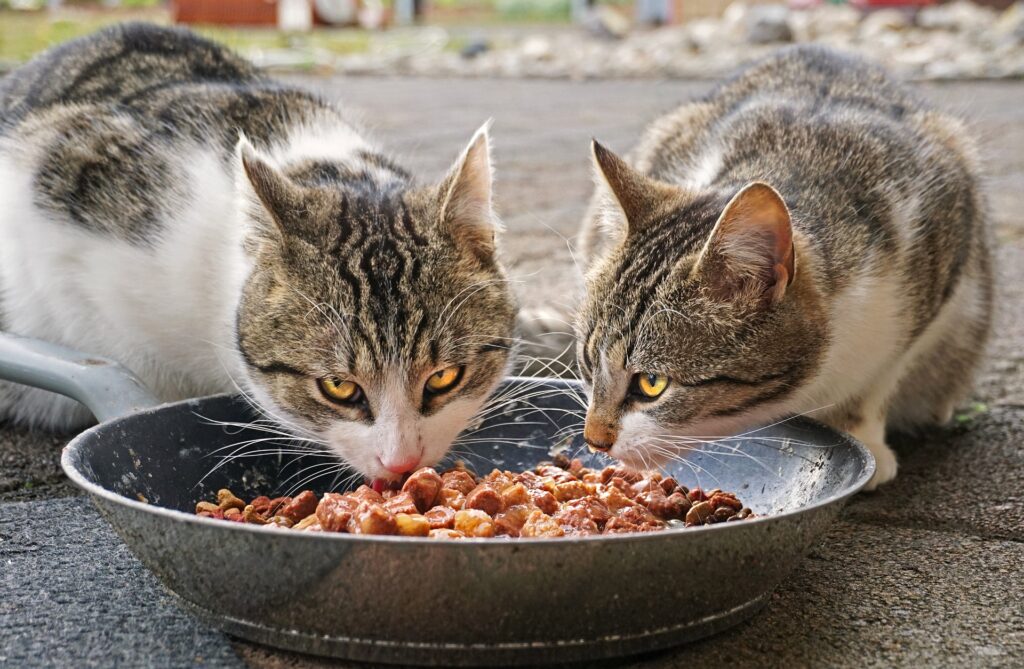
Can my cat have a vegan diet?
The compromise approach is even more important for cats. These are amongst the planet’s true carnivores, obtaining all their dietary requirements from other animals.
The main challenge with minimising the meat in a cat’s diet is that, unlike many mammals (including dogs), cats cannot produce certain proteins. They have to absorb these from the meat and fish in their diet. Amino acids are another issue – cats deficient in the animal-derived amino acid taurine, for example, usually succumb to a specific type of heart problem.
Even a fortified vegan cat food cannot be confidently recommended. Turn the situation on its head, and try to imagine weaning a rabbit onto a meat-only diet, and you get some idea of the challenge – and the ethics – involved.
There are some lab-grown ‘meat’ products in development, with vegan and vegetarian cat owners in mind. However, whether these will arrive – and remain – on the market any time soon is hard to guess.
For many vegan pet owners, there is a huge ethical issue involved in feeding the animals they share a space with. Ethics, however, include the animal’s needs too, and it’s an almost impossible issue to resolve when it comes to cats. If you are able to reduce but not eliminate the meat in your cat’s diet, that’s the safer option.
Top 10 pets for vegan households
There are, of course, plenty of other pets that don’t eat meat, or that eat some meat but can still thrive on a meat-free diet. Here are our ten favourites.
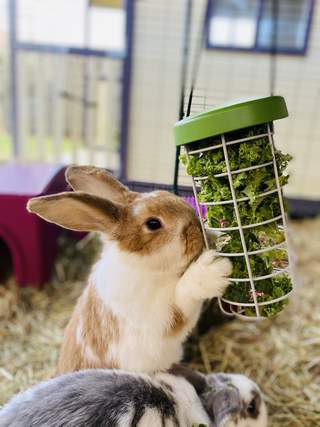 1. Rabbits. No problems here – rabbits are happy vegans, with diets based on hay and vegetables. You could argue that the soft pellets they eject and then eat are animal products of a sort, but they are simply semi-digested vegetation.
1. Rabbits. No problems here – rabbits are happy vegans, with diets based on hay and vegetables. You could argue that the soft pellets they eject and then eat are animal products of a sort, but they are simply semi-digested vegetation.
2. Guinea pigs. Like rabbits, these wonderful little characters thrive on a 100% vegan diet.
3. Hamsters. As most hamster owners feed their pets with shop-bought hamster food, they may not be able to say exactly what the ingredients of that food are. However, vegetarian and vegan hamster foods are readily available.
4. Gerbils. Like hamsters, gerbils are omnivores that can live happily on a vegan diet. They tend to have rather delicate stomachs, so feeding them with a high-quality pellet mix is essential. Too much fresh stuff can cause problems.
5. Mice. Although they will eat pretty much anything in the wild, mice can thrive on vegan diets; but it is still best to use a food mix prepared specifically for them. This ensures that they will not be deficient in any of the vitamins and minerals they need.
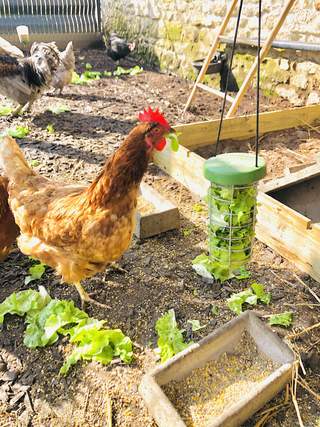
6. Rats. These are the most omnivorous of rodents, but as long as you feed them a vegan mix that has been fortified with all the nutrients they need, they will thrive. Indeed, rats who eat too much animal fat tend to become fat and die prematurely.
7. Chickens. If you watch a free-range hen, it soon becomes clear that she will eat anything – grass, beetles, worms, and everything in your veg patch if you’re not careful! Most chicken feed emulates this mix of plant and animal products. However, it is possible to buy vegan chicken feed, and circumstantial evidence suggests that hens can thrive on it. However, they are likely to produce fewer eggs, and you will not be able to stop them scratching for worms and bugs, no matter how vegan the layers pellets are!
8. Budgies and parrots. Vegans will have no obstacles to face with budgies and parrots, unless the birds are being bred. Egg-brooding female birds need a protein boost, normally delivered via an egg-based food or cooked meat. Vegan alternatives are available, though.
9. Finches. Many finch species enjoy bugs and mealworms as treats, but these are not an essential part of an adult finch’s diet. These birds thrive on a mixture of seeds and fresh vegetables.
10. One for reptile fans. When you think of pet snakes and lizards, you probably have an image of dead mice or doomed crickets. However, there are a few commonly kept pet reptiles that eat a 100% vegan diet, the most popular being the Green iguana. Getting the balance of vegetables just right is very important for the animal’s health, but meat is certainly something you won’t have to worry about.
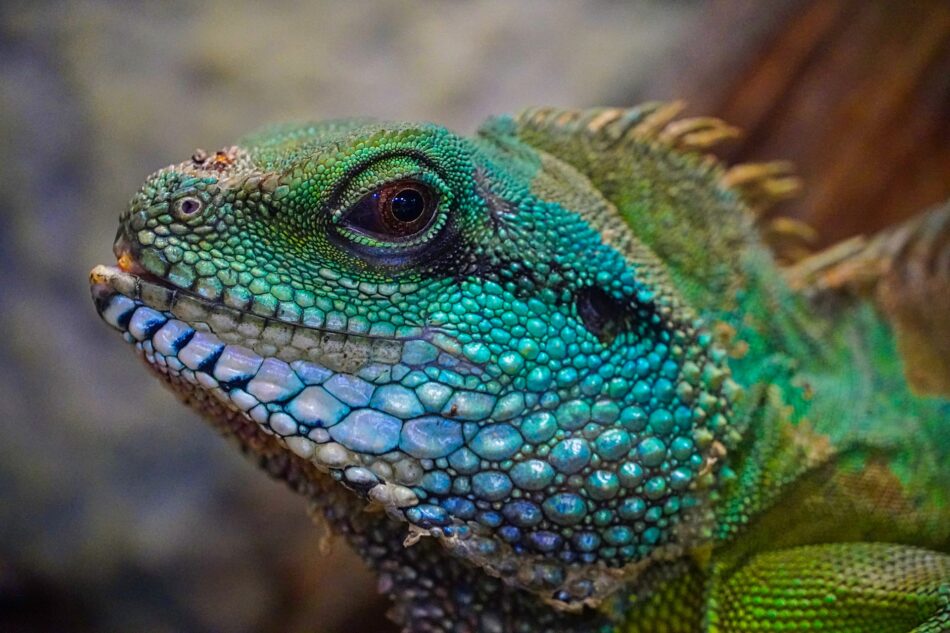
There is no shortage of choice when it comes to vegan pets. Keeping a vegan cat or dog is a much trickier proposition, though. And with all these animals, a balanced diet that matches the pet’s nutritional requirements should be your primary goal.
This entry was posted in Budgies
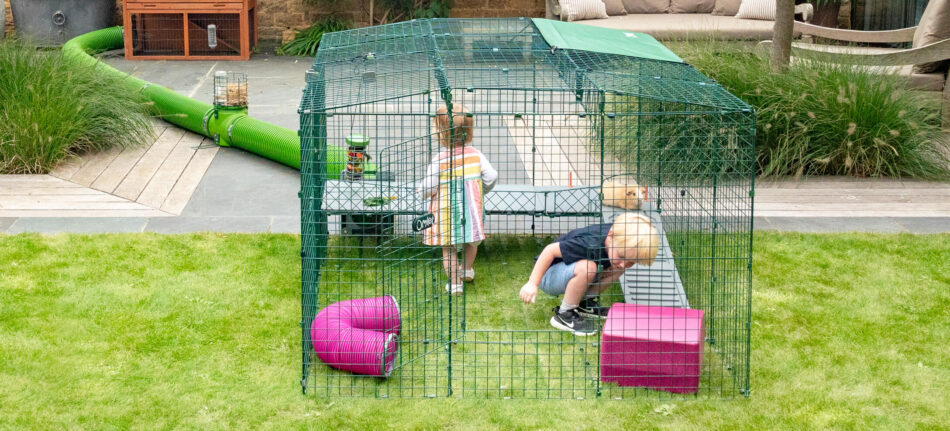
Welcome to guinea pig parenthood! Whilst your new furr baby will be relatively low-maintenance, as with any type of pet ownership, it’s your responsibility to keep your cavy safe and to ensure they live a happy and fulfilled life. But what exactly do you need to do to make sure that your guinea pig is a grinny pig, and is there anything you definitely should not do?
Guinea pigs bedding dos and don’ts
Do use a guinea pig bedding with good absorbency. This will reduce odours, and create a more hygienic and comfortable environment for your guinea pigs.
Don’t use dusty or sandy bedding. As guinea pigs have delicate lungs, breathing in wood or sand dust can be harmful. In their natural habitat, guinea pigs create their homes from larger pieces of wood and debris. Your pets will enjoy constructing complicated nests using larger bedding materials.
Do choose kiln-dried wood shavings – the drying process removes any toxins and oils from the wood.
Don’t choose colour over comfort! If you want to use a multi-coloured paper-based bedding, consider mixing it in with a more natural tone that replicates the wood-and-grass colours of the guinea pig’s natural habitat.
Do use an aubiose-based bedding if possible, as this is naturally less dusty, more absorbent and made from a natural, sustainable material.
Guinea pigs food dos and don’ts
Do give your guinea pigs natural treats such as spinach or broccoli, as this is an essential source of vitamin C in their diets! If your cavies refuse to eat leafy greens, it may be necessary to purchase a vitamin C solution that can be added to your pet’s water.
Don’t overfeed your guinea pigs. If they are leaving bits of food in their bowl each day, feed them a little less.
Do regularly clean out your guinea pigs’ food bowl, as their bedding, fur and general mess will quickly soil the bowl. It’s a good idea to clean your pets’ bowls after each feeding with a wipe or spray.
Don’t give your guinea pig any type of meat or fish. This could lead to illness, and if your guinea pig has accidentally eaten meat, take them to the vet immediately.
Do change your guinea pigs’ water every few days, not only once the bowl is empty. This ensures a clean water supply.
Don’t give your guinea pigs too many treats when attempting to train them. The treats will go further in training if your pet sees them as something really special!
Guinea pig toys dos and don’ts
Do regularly change the toys in your guinea pigs’ run. Your guinea pig’s play will remain stimulating if you often swap the toys around. Your guinea pig may let you know if it’s bored of a toy by chewing or even eating it!
Don’t give your guinea pigs your leftover loo roll cards as a treat, as the chemicals used to treat them could be bad for your pets’ health. Instead, invest in a small tunnel system such as Zippi tunnels, which not only last longer but are safer too.
Do provide plenty of chew toys for your guinea pigs. Your pets will naturally nibble and bite any objects in their cage to maintain the length of their teeth. This can be dangerous if all they have to bite on is the metal cage, so having plenty of different things to chew on is essential.
Don’t put your guinea pig into a wheel or ball toy. Although these are great for our smaller furry friends, the guinea pig’s body is not designed to fit into such a small space. Your guinea pigs will be much happier getting their exercise in a large guinea pig run or enclosure.
Do change the layout of any tunnels or playground you have for your guinea pigs. Many of the play sets available are modular and can be changed to keep the experience fresh for your pets.
Guinea pig cohabitation dos and don’ts
Do make sure that your guinea pigs have plenty of space in their enclosure. If you are keeping a small family of guinea pigs, then it’s important that they have enough room to play and establish their own space within the cage or hutch.
Don’t punish your guinea pigs by putting them into isolation. Separating them from the others will only create further problems and is widely thought to be unhealthy and distressing for them.
Do keep your guinea pigs in pairs of sisters or neutered brothers. This will reduce aggression between the animals, as it lessens their mating urges. It is also possible to keep a neutered male with females, but you will need to wait six weeks after the neutering before introducing them, as males can still successfully mate in those early weeks.
Don’t keep just one guinea pig. Your guinea pig will get lonely when left alone for long periods, and such loneliness can actually shorten their lifespan. Your guinea pig will live a longer and happier life with a friend, so it’s a great idea to get a pair if you are considering becoming a guinea pig owner. Did you know that it’s actually illegal to own just one guinea pig in Switzerland?
Following these tips will make keeping guinea pigs simple and incredibly rewarding. By providing them with a stimulating environment and healthy diet and observing these few dos and don’ts, your pets will have long and happy lives.

This entry was posted in Guinea Pigs
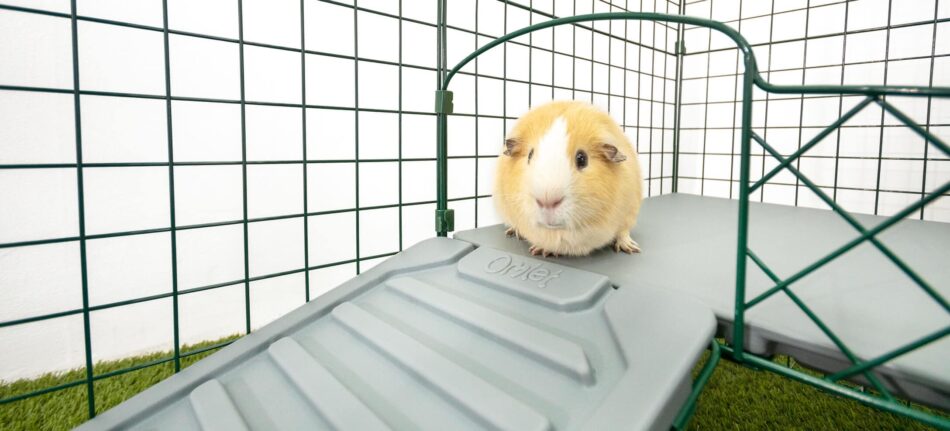
Guinea pigs are highly social animals that thrive on companionship and stimulation. And since a happy guinea pig is a healthy guinea pig, they need plenty of mental and physical enrichment. Toys, treats, and a playmate are just some of the key elements to enriching piggy-play.
Playtime is best spent with pals! If possible, consider adopting guinea pigs in same-sex pairs or trios. Guinea pigs thrive on social interaction, and do best when they have friends that speak their own language! If more than one guinea pig is not an option for you, be sure to engage yourself in piggy-playtime every day. Take note of what your guinea pig likes to do – are they curious and outgoing, or laid-back and shy? Do rolling balls catch their attention? Or do they prefer to chew rather than chase their toys? Knowing each guinea pig’s personality will help create the most enriching environment possible.
Serve food interestingly
Were you ever told not to play with your food? Well, the same rule does not apply to cavies! Mealtimes are a great opportunity to sneak in play and bonding time. Our Caddi Treat Holder is a fun and unique way of serving up your guinea pig’s meals and treats. Making food challenging to reach means more mental and physical reps before reward, and has the added bonus of keeping treats up off the floor. You can also hide food to encourage natural scavenging behaviours in your guinea pig. Place treats in paper tubes, or a hay rack for rummaging fun! Be sure to surround treats with nutritious hay to ensure meals are eaten before dessert!
Guinea pigs can also be fed by hand, but be sure to only offer treats long enough to keep your fingers out of accidental-biting range! Hold treats loosely between your fingertips and release as soon as your piggy has a hold of it.
Another interesting and engaging way to serve food to your cavies is by threading fruits, veggies, or herbs on a rope or skewer stick fastened with knots or clothespins. Be sure that the twine or rope is thick enough to avoid getting knotted around your piggy, and not so long that they can get themselves entangled. A blunt, metal grilling skewer secured to the side of your guinea pig’s enclosure is both chew and tangle-proof.
Guinea pigs are very food motivated, which makes exercising much easier! To give your piggy some extra steps for the day, tie some of their favourite food or toys to the end of a string and drag it along the floor for them to chase! Keep it just out of reach to encourage them to keep after it. Just be sure to let them catch their prize within a reasonable timeframe!
Changing up the menu from time to time helps alleviate boredom while enhancing your guinea pig’s health. Choose seasonal, piggy-friendly fruits and veggies such as melons, apples (without seeds!), or summer squash to add variety to their diets. Guinea pigs are also excellent lawnmowers, and would love time outside to help with the grass! Place them in a secure guinea pig run to move around each day and you’ll be amazed at how much less you’ll need to mow!
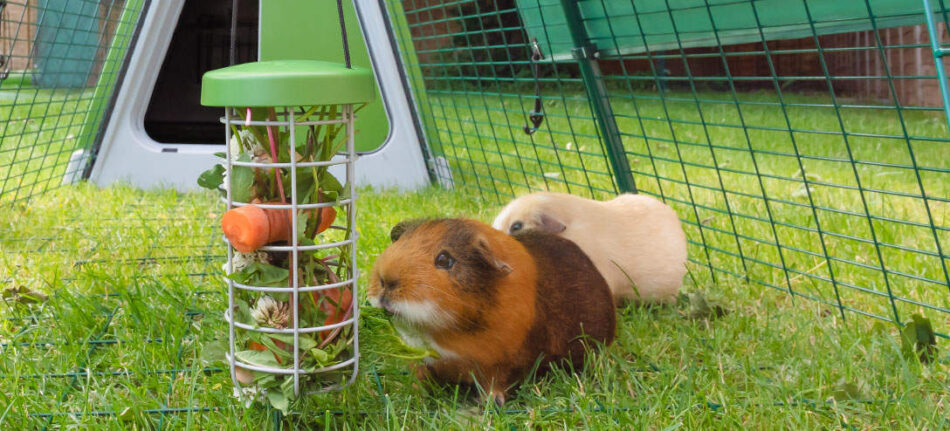
Obstacles, tunnels and tubes
Did you know that wild guinea pigs utilize the burrows and tunnels of other animals? They aren’t known for digging themselves, but they love to spend time in the safety of pre-dug tunnels! As prey animals, they have excellent eyesight – especially toward the sky, scanning for owls and hawks. Guinea pigs thrive in areas with lots of cover supplied by tubes and hideouts. Our Zippi Guinea Pig Tunnel System and Zippi Guinea Pig Play Tunnels allow for hours of play for your piggy and viewing enjoyment for you! Watch your piggy zoom through tunnels (or maybe even take a nap!) and weave their way through a course of your own design. Change the configuration routinely to further challenge your guinea pig. Bonus tip: hide some treats along the way, and you’ll have one happy cavy!
Make use of those shipping boxes! Guinea pigs love a good challenge, so create an obstacle course using a combination of tunnels, tubes, and cardboard boxes. Just be sure to discourage the nibbling of the cardboard obstacles!
Vantage points
While they feel most comfortable in the safety of tubes and tunnels, guinea pigs enjoy a good climb! They’ll routinely scout their surroundings looking for dangers, so giving them an elevated space will help them feel more comfortable. This is another place to get creative! Build platforms from cardboard tubes, boxes, or add our Zippi Guinea Pig Run Platforms to your piggy’s space to add levels of fun.
Toys
Some guinea pigs enjoy carrying or pushing small toys around. Guinea pig toy ideas include: small plastic balls, untreated willow or dried grass weaved-orbs, and small stuffed toys. Specially made guinea pig toys can be found at most pet stores, or choose small balls and stuffed toys from a selection of cat toys. Ensure that any small, glued-on accents are removed to prevent your guinea pig from ingesting something they’re not supposed to! And make sure each piggy has their own toy- they may be sociable, but not every piggy wants to share their favourite toy!
You can also leave toys in their cage for them to entertain themselves while you’re away. Bird toys, or toys made for rabbits and guinea pigs can be hung from the top or sides of your piggy’s cage to provide hours of fun! Be sure to remove any bells from bird toys that are small enough to swallow. Chewing sticks made from applewood are another must-have for cage enrichment. Guinea pigs have teeth that continuously grow, and need to gnaw on wood to keep them trimmed to an appropriate length. Applewood sticks come in a variety of shapes and sizes, most of which are perfect for your cavy to carry around and gnaw on at their leisure!
Shapeable log bridges are another great cage improvement for your guinea pigs. They can be formed into hides to run under, walkways to run across, ramps, dividers…your imagination is the limit! Untreated garden edging works too – just be sure to purchase a material that won’t harm your piggy should they taste it.
Toilet paper or paper towel rolls are great for creating treat-stuffing toys, or cut them down to create pillars for homemade platforms. Wrapping paper tubes are extra-sturdy for cavy construction projects! If your guinea pig is young or on the small side, be sure they can’t get their heads stuck inside any tubes they have access to.
Moving furniture
Guinea pigs need to be kept on their toes for optimal health. Another simple way to create a new and exciting environment for them is to rearrange their furnishings every time you clean their cage or enclosure. Move around their guinea pig shelters, playgrounds and guinea pig viewing platforms, and they’ll set off re-exploring their territory with gusto!
After all of this exhausting play, your guinea pig will probably want to take a well-earned nap. Popular snooze-space options among guinea pigs are fleece hammocks or blankets. These cosy bed options will be a fast favourite with your cavy! Make sure to wash your piggy’s bed of choice in the washing machine or by hand to keep it fresh!
Accessories to avoid
Toys: Watch out for toys with sharp edges, small attached accessories that could pose a choking hazard, or harmful materials such as treated wood. Also be wary of materials such as soft rubber or plastic that pieces can be bitten off of and swallowed.
Exercise balls and wheels: While guinea pigs may look like large hamsters, their anatomy is quite different. Guinea pigs are not comfortable in an exercise ball or wheel, and can seriously injure their backs or feet if placed in one. Ventilation is also important for guinea pigs, and exercise balls in particular do not allow for enough airflow to keep your piggy cool.
Bridges: Guinea pigs are adorable, but not graceful! Make sure all provided bridges either have rails to prevent accidental falls, or are low enough to the ground or level below them to provide a safe place to land.
Leash/harness: A walk may sound nice, but even the most friendly and trusting guinea pigs can panic on the end of a leash. Cavies are “flight” animals by nature, and will harm themselves struggling against a harness or leash if pulled on. A better option would be playing the string-drag game mentioned earlier, or a snuggle session on the couch with their favourite human friend!
Creating fun games and environments for your guinea pig is rewarding for both of you! Playing with your piggy builds trust, and there’s no faster way to their hearts than through food! By treating them often, playing even more often, and giving them ways to entertain themselves while alone, you’ll ensure they’re living their best life!
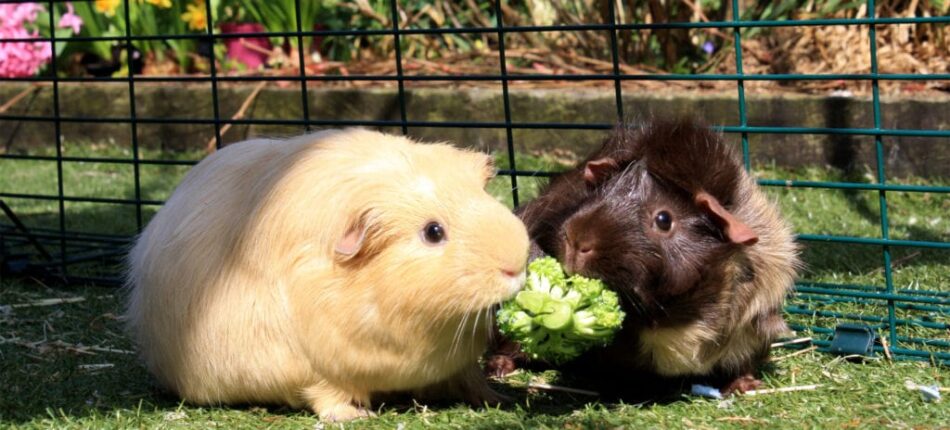
This entry was posted in Guinea Pigs
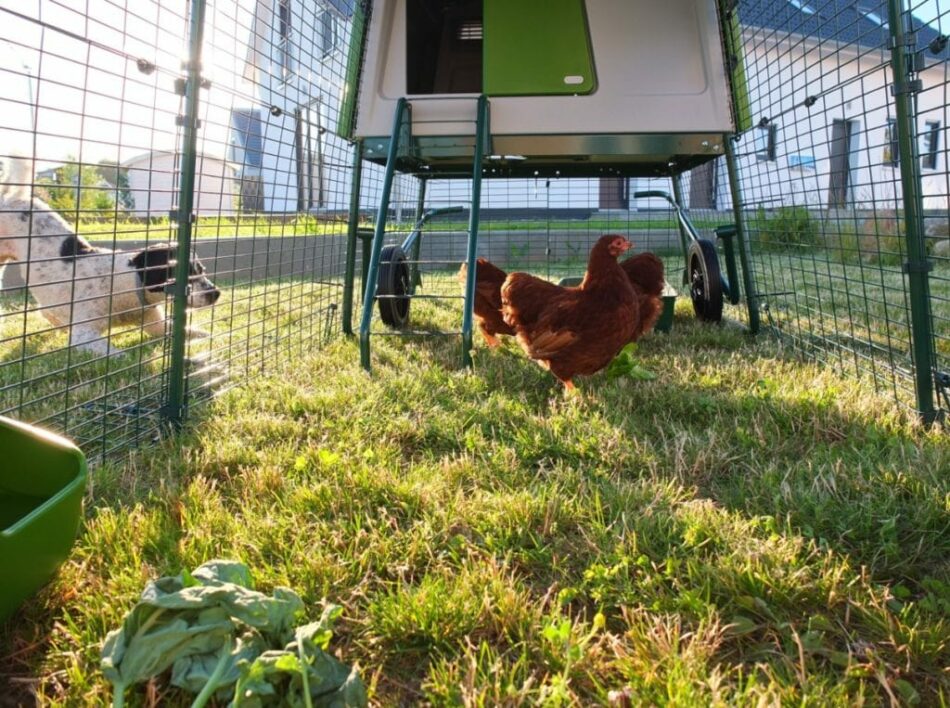
You can keep chickens with other pets when the proper preparations and precautions are in place. Some pets like cats and dogs may have an innate prey drive that chickens can trigger, so it’s important to take introductions slowly to ensure success. With these tips, you’ll be able to confidently introduce your current pets to your chickens, or introduce new pets to your existing flock with confidence.
Keeping chickens with dogs
Dogs are the most common pets in the world, with millions kept as pets across the country. So, if you’re among the many dog owners, adding chickens to your family is possible once you consider your dog’s temperament and trainability.
Assessing your dog
If you’re a dog owner, the first thing to consider is their temperament. Different dog breeds may also react differently to birds as part of their nature. For example, breeds like Labrador Retrievers or German Shorthair Pointers may become easily excited around birds due to their natural hunting and retrieving drives. Other breeds that may have increased prey drives include:
Regardless of their breed, if your dog becomes excited or overly curious around small animals, their behaviour will likely carry over to chickens. If your dog loses their mind over the birds at your backyard feeder, or drags you to investigate the park ducks on your evening walks, they’ll likely stress out your flock – and themselves.
Dogs without a prey drive or with little interest in birds will likely not pose a problem to your chickens, but all dogs react differently when new pets enter their territory. Usually, most dogs will adjust to the new backyard occupants just fine after an acclimation period. You will likely see your dog expressing interest in your chickens at first – hanging around and sniffing the coop. They may even express a desire to interact with your chickens through playful postures and behaviours. Understanding your dog’s body language around your chickens will help you determine what their relationship will be like.
Chickens are prey animals, and can be hurt easily. Dogs cannot play with chickens as they would with other dogs or even other pets. It’s important to teach your pup that chickens are fragile friends – not toys or something to hunt.
Teaching dogs to get along with chickens
Unless leashed walks make your dog overly excited, their first encounter with your chickens should be done with a dog collar and lead. Make sure their collar is tight enough that they don’t slip out, but not so tight that it’s uncomfortable. Walk your dog up to your chickens’ enclosure and let them sniff. Maintain a tight leash until you see your dog’s reaction, and allow the lead more slack slowly to reinforce good behaviour.
Let your dog watch you spend time with your chickens. This should be done with your chickens in the safety of a strong walk in chicken run. If your dog does more than sniff or hang around the run, take a step back and approach their interaction from a different angle.
It could take several weeks for your dog to fully accept your chickens. Some other ways to help your dogs adjust to your chickens include:
- Setting up chicken fencing around the outside of your flock’s run for your dog to observe them at a distance.
- If your dog has a run or playpen, place it next to your chickens’ run and slowly decrease the distance over several days until they are side-by-side.
- Reward your dog with their favourite treats each time they are calm around your chickens.
Make sure to never leave your dog unattended with your chickens – especially in the beginning. Even if they can’t get into the run with them, an excited dog’s barking can easily stress your flock out.
Keeping chickens with cats
Cats are more difficult to train than their canine counterparts, and are decidedly less predictable in their behaviour. But the good news is that most cats don’t see a large hen as potential prey the same way a dog might. Most cat owners will agree that their cats show little to no interest in their chickens. In fact, cats and chickens have a somewhat symbiotic relationship.
Birds and their feed attract rodents, which a cat would much prefer over your hens. So, when your cat is able to patrol your chickens’ surroundings, chances are good that any potential rodent problem will be nipped in the bud.
Some cats may show increased interest in your hens. This largely depends on your cat’s breed and temperament. Cats will pose a greater threat to chicks rather than grown hens, but by keeping your flock in a strong chicken coop and run, you’ll ensure they stay safe from your cat.
Keeping chickens with guinea pigs
It may be tempting to keep some cute cavies in with your chickens, but in reality it’s not wise. Chickens will likely pick on them, and with their short legs, guinea pigs can’t get away from them quickly. Their dietary requirements are also very different, and your chickens may eat your guinea pigs’ food in favor of their own, which means neither animal will be getting the nutrients they need. If you have cavies and want to house them near your chickens, it’s best for them to have their own guinea pig hutch and run.
Keeping chickens with rabbits
Rabbits on the other hand are fast enough to fend for themselves against chickens, and if raised together from a young age, can do well around chickens. Still, they require their own dietary needs and clean sleeping quarters. They don’t roost like chickens, so they’ll need their own burrowing space in the run or under the coop.
The easiest way to achieve this is by adding walk in chicken run partitions. This will allow you to create “rooms” for each species to ensure they all get what they need. You can open the partition doors to allow everyone to be together whenever you’d like, or create a third space as a common area.
Remember to try to give each species as much space as possible in their respective areas to make them feel safe and comfortable.
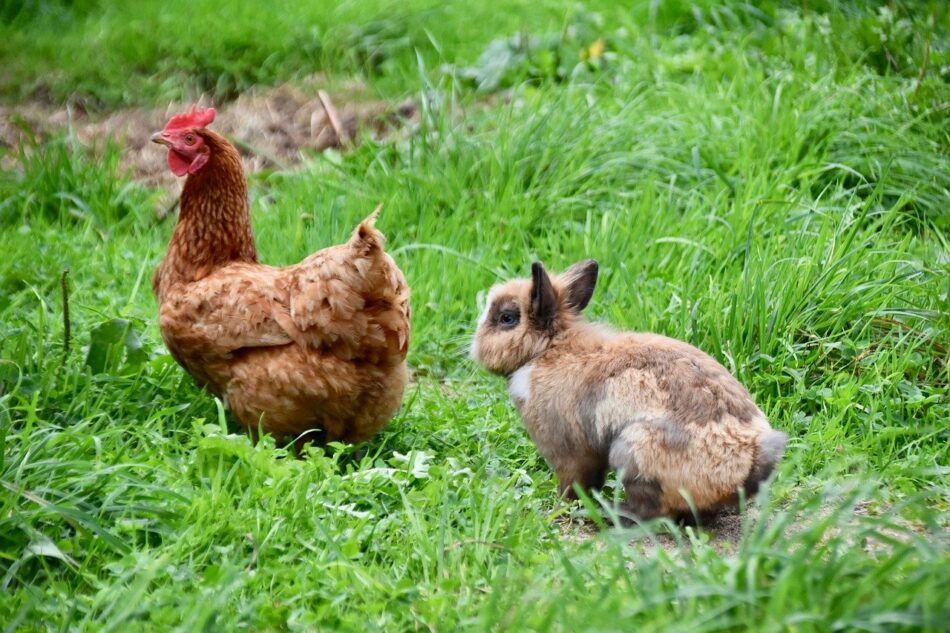
Chickens and other pets
Chickens can also mix happily with goats, and with female ducks (males will tends to bully them). Ironically, they do not mix with birds in an aviary. They will eat anything that falls to the aviary floor, but they will also happily peck the other birds whenever they can and may attract rats and mice, which will cause problems for the smaller birds.
If you live in a rural setting, you can keep chickens with other barnyard animals. Chickens mix happily with:
- Goats
- Sheep
- Cows
- Alpacas or llamas
- Pigs
- Female ducks, guinea fowl, peacocks, geese, or pheasants
Any other avian species kept with chickens should be docile and preferably female, as males can bully hens. Smaller birds like quail or pigeons will likely get pecked at by chickens, so it’s best to stick with larger birds as run-mates. Small pets like hamsters, gerbils, turtles, or frogs should never be kept with chickens – they will be pecked at and killed.
Omlet and your pets
Omlet has all of the pet products you need to keep your furry and feathered family members healthy and happy. Having multiple types of pets is exciting, and through our line of chicken coops, chicken runs, and walk in run partitions, you’ll be able to create a safe haven for all of your animals to enjoy. And, by knowing that Omlet products are protecting your flock, you can rest easy knowing that you’ve provided them with the best chicken housing solutions available.
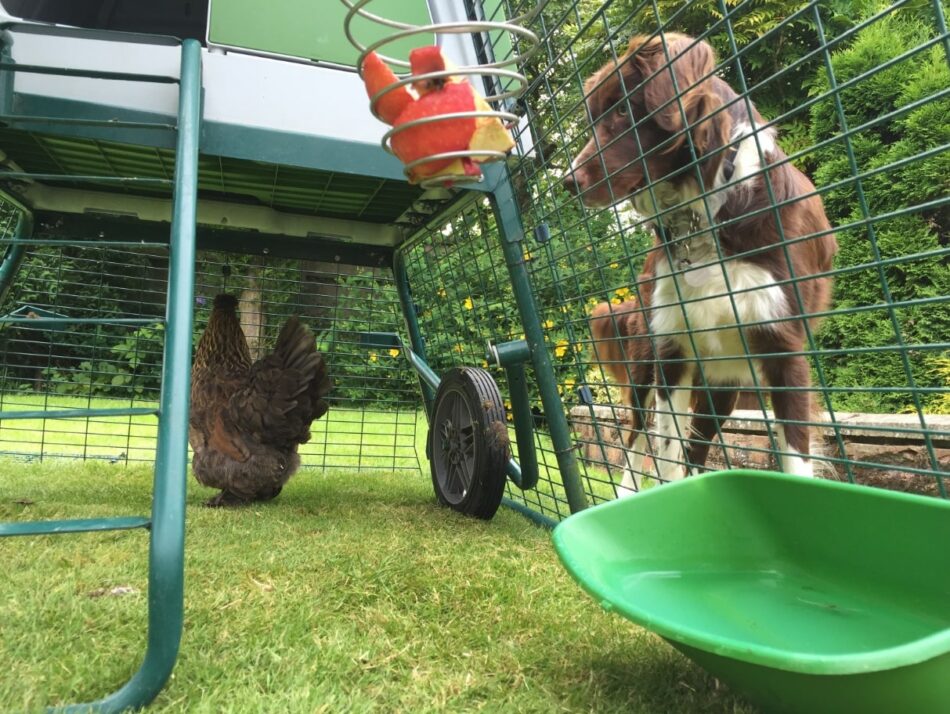

This entry was posted in Budgies
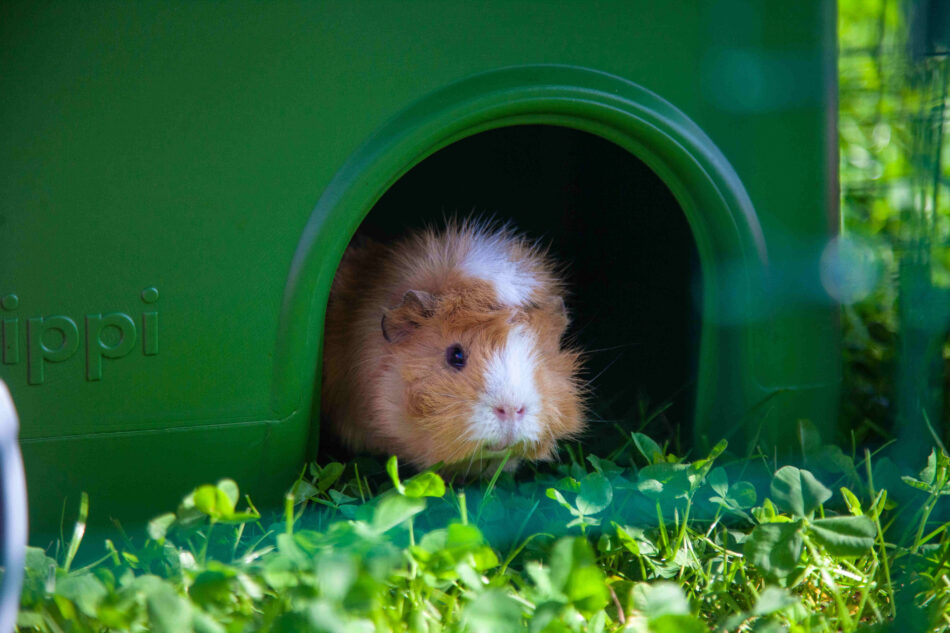
Guinea pigs are very popular small pets! Not only are they adorable and cuddly, but are great with children, making them a top pick.
But, it can be initially tricky to get to grips with the behaviours of cavies. However, by using sounds and postures, guinea pigs can say a lot. Though you may not understand all their body language and the noises they make, you can learn to understand what have clear meanings.
Positive sounds – how do you know your guinea pig feels comfortable?
Chutting: AKA “I’m having fun!”. Sometimes referred to as a “clucking” sound, like a mother hen would make, this is a sound of guinea pig contentment. Your cavy may make this sound towards you when you’re interacting with them, or towards their house mates, when enjoying the moment. They may also make this sound when they’re curious and exploring their surroundings.
Cooing: This sound communicates reassurance. It’s a sign of affection that cavies do for humans they love and for their young.
Purring: Guinea Pigs who feel contented and comfortable while being petted or cuddled, will make a deep purring sound, accompanied by a relaxed, calm posture.
Snoring: Yes, you’ve heard right. Guinea pigs can snore as well. If your buddy is relaxing on your lap and snores, it means he feels comfortable. Please note that if your guinea pig begins to make similar sounds to snoring or wheezing/clicking when breathing, be sure to check for any symptoms of illness with your vet.
Wheeking: AKA “Feed me!”. This is a distinctive and common vocalisation made by guinea pigs and it’s most often used to communicate excitement or anticipation of getting some tasty treats when their owner opens the treat box. It sounds like a long and loud squeal or whistle.
Whistling: Guinea Pigs may sometimes whistle without intending to because they are very excited about something.
Negative sounds – how do you know your guinea pig feels uncomfortable?
(Teeth) Chattering: AKA “Stop that!”. This is an aggressive vocalisation and shows an agitated or angry guinea pig which is ready to attack. As the name implies, teeth chattering is often accompanied by the guinea pig showing its teeth, which looks like a yawn.
Purring: If the purr is higher pitched, it’s often an indicator of annoyance and sometimes sounds like a piercing vibration. A short purr may indicate fear or uncertainty and you will notice your guinea pig remain motionless. In both circumstances, it is best to reassure your guinea pig softly.
Hissing: Like chattering, this is a sign of a guinea pig who’s angry or aggressive. It’s just like the hissing noise that a cat makes.
Shrieking: A piercing, high-pitched squeak called a shriek is a fairly unambiguous call of alarm in terms of fear or pain a guinea pig feels. If you hear this sound, check on your guinea pig to make sure everything is alright and it’s not hurt.
Squealing: You will hear this sound if your furry friends are feeling unhappy or distressed. Usually this sound comes when they’re bullied or bitten by other guinea pigs.
Whining: AKA “I don’t like this.” A whining or moaning type of squeak can communicate annoyance or dislike for something you or another guinea pig is doing.
Chirping: Just like a bird, chirping is perhaps the least understood or heard noise that guinea pigs make. This sound is made when cavies are taken away from their family. A chirping guinea pig may also appear to be in a trancelike state.
Body Language – what are positive postures?
Popcorning: This gesture consists of hopping straight up in the air, sometimes repeatedly, just like popcorn does while it is popping. The usual reason is happiness and excitement. They’re simply having a good time, they become excited, and pop – they are literally jumping for joy! Not all guinea pigs entertain their owners with “popcorning”, but most do. For more information on this, please refer to our previous blog Why Do Guinea Pigs Popcorn?.
Licking: This is a super friendly signal! If your guinea pig is licking you, it is usually a sign of affection, that they’re content and are trying to groom you – it’s possible though that they just like the taste of salt on your skin.
Sprawling out: This is usually a sign that your guinea pig is feeling comfortable and safe with you while relaxing on your lap.
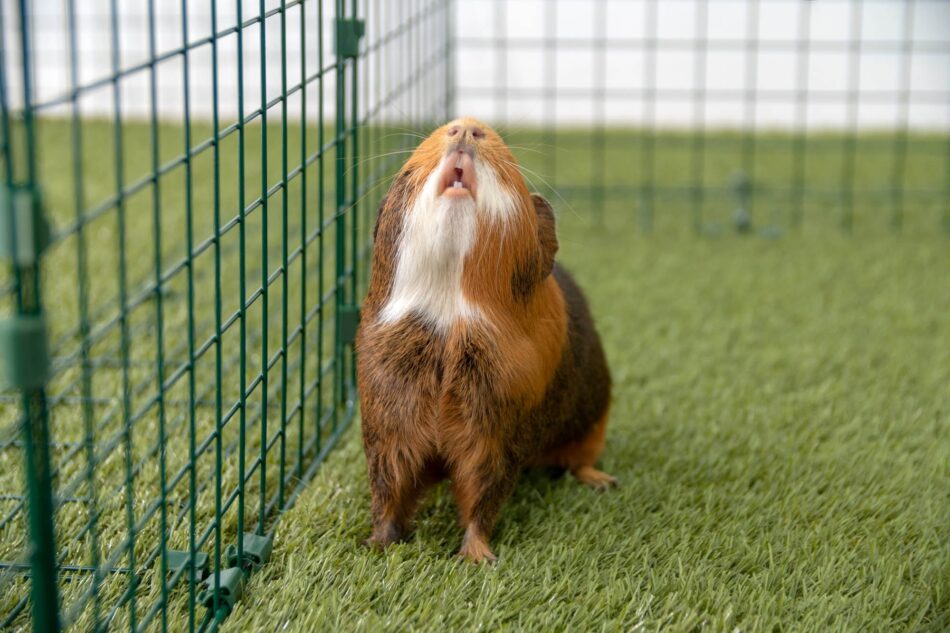
Body language – what are negative postures?
Backing away: If you’re trying to pick up your small friend and they’re backing away from you, this could be a sign that they feels threatened and uncomfortable. Please back away and give your pet some space. It’s important not to forget that guinea pigs are prey animals, so their instinct is to run away if they feel threatened.
Fidgeting or biting while being held: This can often be a sign that your guinea pig just needs to go to the bathroom. On the other side, it can also indicate that your guinea pig feels uncomfortable, stressed or even scared – or is just tired of being held. Either way, try returning your guinea pig to its cage for a bit.
Freezing: If a guinea pig is startled or uncertain about something in its environment, it will stand motionless. Reassurance will release them from their nervous freeze.
Strutting: Moving side to side on stiff legs can be seen as an act of dominance or aggression, often accompanied by teeth chattering.
Tossing head in the air: A guinea pig will toss its head back when it’s getting annoyed being petted as a way of asking you to stop.
Standing on two legs: If your cavy stands on two legs and bares its teeth, it could be a sign that a fight is about to happen among him and his mate(s). To prevent injuries, it may be necessary to intervene here. It is recommended and important to try and prevent this behaviour if you’re introducing other guinea pigs for the first time.
What are neutral sounds & postures?
Mounting: This can be either sexual behaviour (males to females) or behaviour used to show dominance within the guinea pig herd’s social structure, especially between females.
Scent marking: Guinea pigs will rub their chins, cheeks, and hind ends on items they wish to mark as theirs. They may also urinate on things or other mates to show their dominance.
Sniffing: Sniffing is a way to check out what is going on around them and to get to know others. Guinea pigs particularly like to sniff each other around the nose, chin, ears, and back end. Sniffing is a way guinea pig’s explore.
Raising heads: This is usually a sign of dominance when they raise or stretch their heads with their cage mates.
Rumbling: A guinea pig rumble or rumble strutting is deeper than a purring noise. A male guinea pig makes this sound while trying to mate with a female, it is part of their mating ritual and often accompanied with a typical “mating dance”.
Running away from being picked up: Guinea pigs tend to be timid, especially at first. If they’re running away from you it’s not a rejection intrinsically but rather a natural defence mechanism. Just give them a bit of time and patience and they’ll be happy being picked up for cuddles and playtime outside of the cage from time to time.
Yawning: Like raising heads, your guinea pigs could be showing dominance when exposing their teeth to others.
Be sure to take a careful note of your furry friend‘s behaviours and after a while, you‘ll have a better understanding of it. Remember it may take a while for your furball to get used to being handled. Your guinea pig may interact with you differently than the way it does with their mates.
To provide your cavy a happy and healthy life and in order to prevent stress or depression, socialising and playtime are important parts of a guinea pig’s life. If you want to know how to teach your furball some nice tricks, check out our previous blog How to Teach Your Guinea Pigs and Rabbits Tricks.
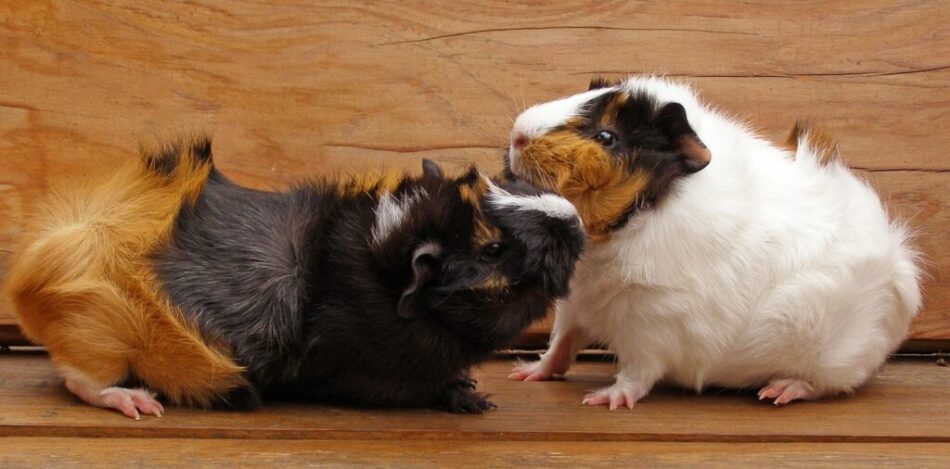
This entry was posted in Guinea Pigs
Wondering how to teach your guinea pigs and rabbits new tricks? One of the most rewarding experiences you can have with your pets is through teaching them tricks— and it’s a lot easier than you might think. Rabbits and guinea pigs are social animals that benefit from spending time with their owners through learning and playing. Discover how teaching your pets new tricks is a fun way to build their trust and confidence.
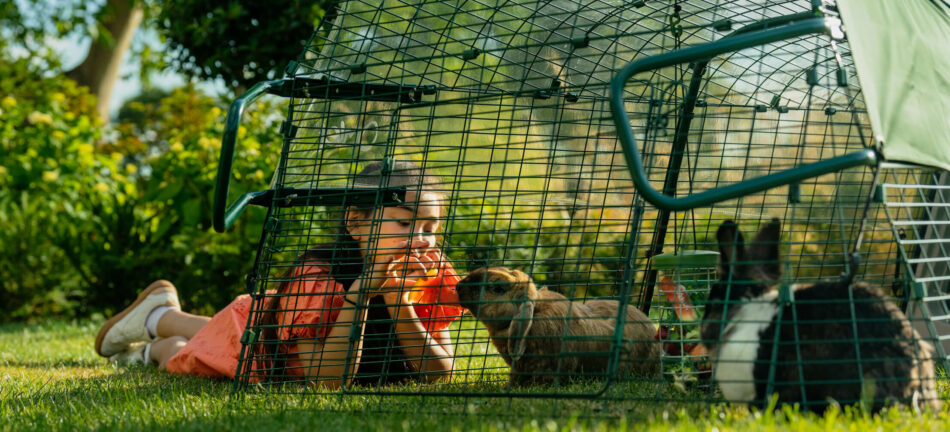
How to start training your guinea pigs and rabbits
Training rabbits or guinea pigs is most effective when you can repeat it every day – even if it’s only for five or ten minutes. Not only will your pets appreciate the extra attention, but having a repeated routine will help them remember the tricks you’ve taught them.
To teach your guinea pigs and rabbits tricks, the first thing you’ll need is a quiet space free from distractions. Zippi Rabbit Runs and Playpens are ideal, giving you a secure and familiar space where you and your pets can focus. You will also need some of your rabbits’ and guinea pigs’ favourite treats to encourage them and reinforce their learning.
It can be helpful to separate your pets when training them, but some pets can benefit from learning from each other. For example, if you have an older trained rabbit and a young, untrained one, the young rabbit can learn tricks easier by copying their more experienced friend. And don’t worry about old dogs and new tricks – your pets are never too old to pick up new things.
Rabbit and guinea pig tricks for beginners
When you start to train your guinea pig or rabbit, it’s all about patience and perseverance. Your pet might not seem interested in learning initially, but as you continue to reinforce their learning with treats, you will find them routinely coming back for more. Start with something simple, such as “circling” — a perfect trick for both rabbits and guinea pigs.
Training your rabbit or guinea pig to circle
To teach your pet how to perform a circle, grip a treat tightly between your fingers and hold it close to your pet’s mouth. Then lead your pet around in a circle with the treat, so that it spins in a tight circle. Repeat this until your pet spins around without you leading them, occasionally reinforcing them with the treat. It’s important that you only give them a reinforcement treat when they successfully do the trick. Eventually, the flick of your wrist will be all the encouragement that your pet needs to perform this trick — provided that there’s a treat in store for them after their performance.
Don’t worry if this takes some time to learn – the first trick can be the hardest for your rabbit or guinea pig, but once they have mastered a circle, you’ll both have the confidence to learn even more tricks. If your pet is struggling learning how to circle on command, try encouraging them to turn in the other direction. Like us, our pets are either left or right-footed, so the direction you ask of them needs to be in line with their natural inclination.
How to make rabbits or guinea pigs come when called
Another great first trick is teaching your rabbits or guinea pigs to come when they’re called. Not only is it endearing and impressive, but it’s also practical for your pet to approach you on command.
As with many tricks, the key to teaching your rabbit or guinea pig to come when called is food. Offer a treat when you are close to your pet while saying their name. Eventually, they will come to associate their name with the treat. The next step is to call your pet from farther away, showing them the treat. Repeat their name as they take their reward. After two weeks of this regular exercise of calling and treating, try calling your rabbit or guinea pig’s name without showing them a treat.
Moving on to more advanced tricks
Once you and your guinea pigs or rabbits have mastered a first trick, it’s time to move on to more advanced feats. The more tricks your pet learns, the more confident they will become — and the closer your bond will be.
How to teach rabbits and guinea pigs a ‘figure of eight’
Challenge yourself and your pets by encouraging them to walk in a figure eight between your legs. As with teaching them to circle, hold a treat in front of your rabbit or guinea pig while encouraging them to follow a figure of eight pattern through your legs. Reward them with the treat as soon as the pattern is complete. Some pets may need a treat halfway through their pattern to maintain their focus — but eventually they’ll learn to complete the figure eight before expecting their reward.
How to make rabbits and guinea pigs jump through hoops
To teach your rabbit or guinea pig to jump through a hoop, you’ll need a stick and some treats. Begin this method of stick-training, hold the tip of the stick near your rabbit or guinea pig. When they turn to investigate it, offer them a treat. This will reinforce the idea that the stick is associated with treats.
Once they’re familiar with this routine, hold a hoop close to your rabbit or guinea pig, slightly off the ground. Hold the stick on the opposite side of the hoop, and wait for your pet to hop through to the stick. Offer a treat as soon as they’ve completed the hop. Once your rabbit or guinea pig is hopping through the hoop toward the stick, you can offer the hoop without the stick. Reward them with a treat as soon as they hop through.
You can slowly increase the height of the hoop for rabbits, but keep in mind that guinea pigs will only be able to perform a slight hop. Rabbits can reach impressive heights thanks to their acrobatic prowess, so be sure to offer a challenge to them.
Remember: treats are in moderation
Don’t forget that the treats given to your pets are a part of their diet — and if you’re sticking to your daily training, you may need to incorporate healthier snacks as training-treats to make sure their diet remains balanced. Leafy greens, green beans, carrot tops, or herbs are all great treats that are both healthy and satisfying for your guinea pigs and rabbits.
Omlet and your guinea pigs and rabbits
Help your rabbits and guinea pigs reach their full potential and amaze yourself in the process. With Zippi Tunnels and Zippi Run Platforms, you’ll be able to teach your pets new tricks with ease, and give them the elements they crave in their environment between training sessions. And, with our outdoor rabbit and guinea pig runs, you’ll have the space you need to achieve all of your trick-teaching goals.
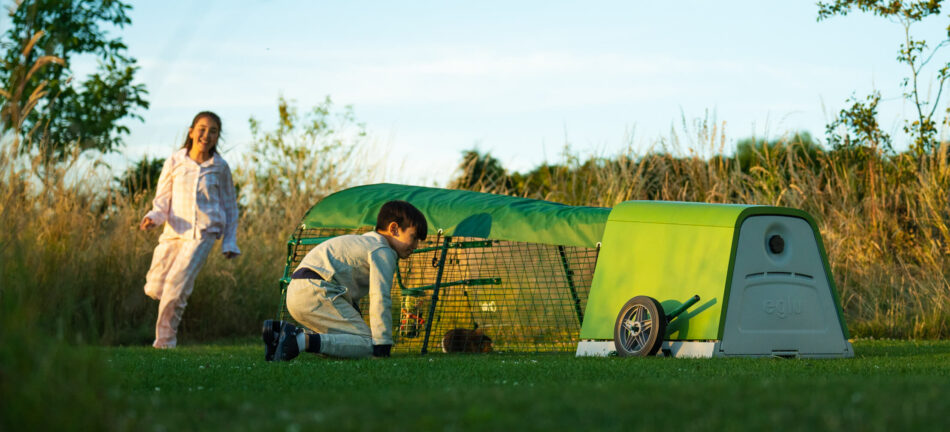

This entry was posted in Guinea Pigs
Guinea pigs are small animals that are increasingly finding their place in homes. Affectionate, they will make your children happy. However, in order for them to flourish at their best, it is necessary to take care of your pets by meeting their needs perfectly. The health of your pet depends on vitamins and a specific diet.
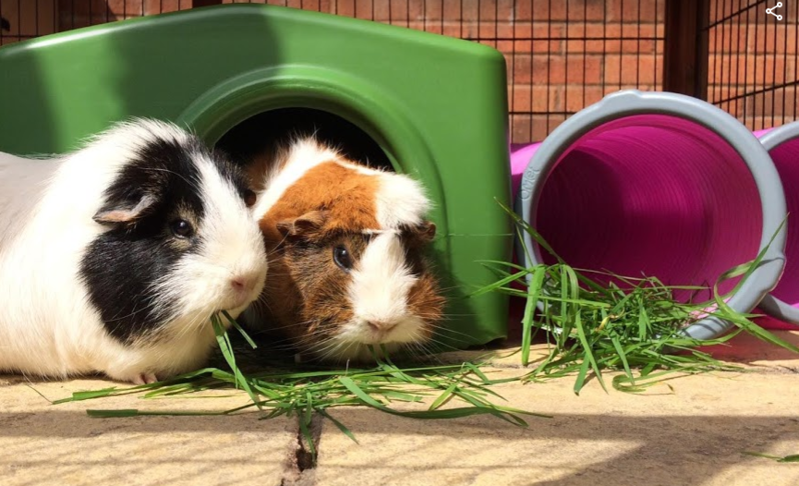
Follow our advice to ensure that your guinea pig receives an adequate daily intake of vitamins and stays healthy.
Why should I give my guinea pig vitamin C?
Just like humans, guinea pigs do not synthesize vitamin C (also called ascorbic acid). Due to an old genetic mutation, our favourite little pets can no longer make vitamin C from glucose. The intake of vitamin C in their diet becomes a necessity.
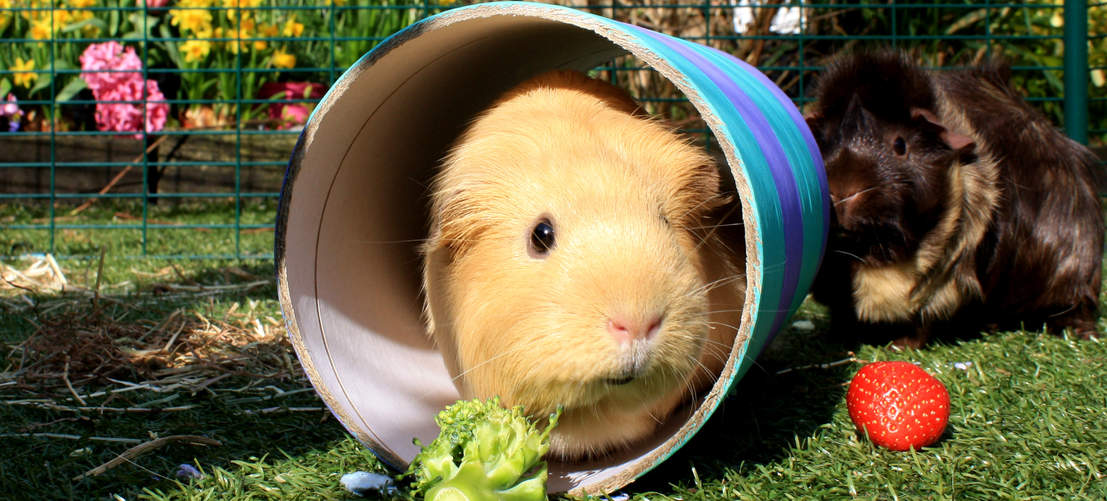
Vitamin C is a molecule that slows down the aging of cells, helps prevent the risk of infections and accelerates healing, therefore, vitamin C intake should not be taken lightly since deficiencies can cause serious health problems in your pet.
The signs of vitamin C deficiency are plentiful and here is what should alert you:
- Your guinea pig is losing weight, does not want to eat or eats differently
- For young guinea pigs growth retardation may be visible
- Your guinea pig’s immune system slows down which can cause many infections. There are also problems with the joints and difficulties for moving. It is important that you be alert to any lesions or sores that may have difficulty healing. If your guinea pig squeals when you pick him up, that’s not a good sign.
Should I give my baby guinea pig vitamin C?
The answer is yes. It is recommended that you give your guinea pig the vitamin from an early age so that it does not suffer from deficiencies.
In addition to vitamin C, which we will focus on in the rest of our article, your guinea pig also needs its dose of vitamin E. Much less mentioned than the previous one, vitamin E is also necessary for maintaining the good health of your pet. If your guinea pig is deficient in vitamin E it may be suffering from muscle problems and this may also be the cause of high mortality in female guinea pigs. This vitamin participates in the production of cells, it therefore has an essential role.
A little tip for vitamin E: between 3 and 5g of vitamin E should be contained in 100g of food.
Foods rich in vitamin E: fennel, broccoli, tomatoes, spinach, peppers and oatmeal.
What foods naturally contain vitamin C?
Many fruits and vegetables contain vitamin C. These foods are easily found in the supermarket. It’s even better if they come from your small vegetable garden! Always wash vegetables and fruit before feeding them to your guinea pig. It is important to present them to your pet as a treat, he will appreciate it more. Do not hesitate to vary his diet by offering different vegetables according to the seasons.
Key figures: the daily intake of vitamin C in guinea pigs should be 20 mg / kg of body weight for an adult guinea pig. This dose can rise to 60 mg / kg of body weight for a growing guinea pig, a pregnant female or a sick guinea pig. If you want personalised advice for your guinea pig, do not hesitate to ask your vet.
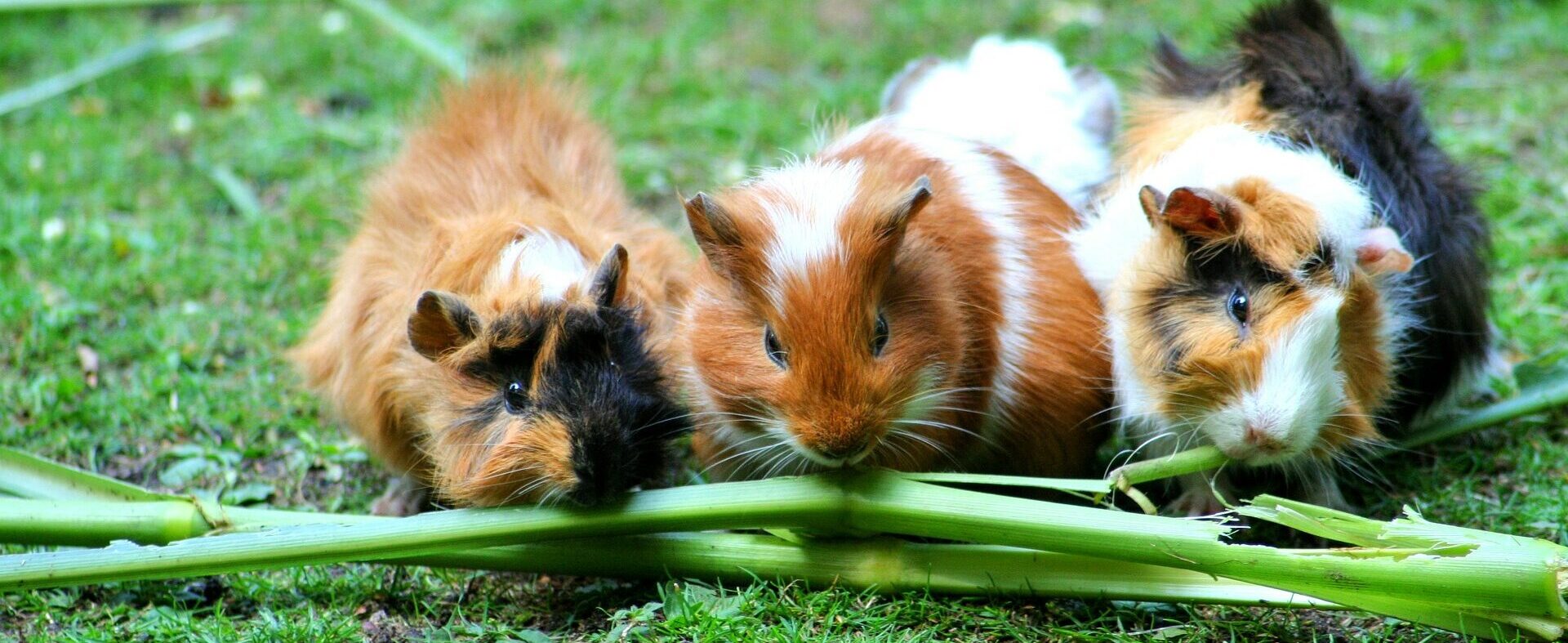
Foods rich in Vitamin C suitable for guinea pigs in 150 g portions (be aware, it is not a question of giving 150g of the same vegetable but of varying the plate):
- Horseradish:contains 141 mg.
- Parsley: contains 140 mg.
- Kale: contains 120mg. Be careful, this food should be eaten in moderation since it may cause bloating in your animal, just like other types of cabbage (Brussels sprouts, cauliflower, white cabbage, red cabbage, green cabbage, etc.)
- Fennel: contains 120 mg.
- Red Pepper: contains 126 mg. Red peppers contain more vitamin C than green peppers.
- Broccoli: contains 93 mg.
- Dandelion: contains 58 mg.
- Chicory: contains 24 mg.
- Radishes: contains 23 mg.
- Tomatoes: contains 19 mg. In addition to providing vitamin C, they are rich in water.
- Zucchini: contains 10 mg.
- Celery: contains 7 mg.
- Cucumbers: contains 5 mg.
This list is not exhaustive, but gives you an overview of foo
ds rich in vitamin C which you might already have at home! We advise you to vary your intake and ask your vet for more information.
Small dietary reminder: do not feed guinea pigs rhubarb, onions, leeks, chives, garlic, avocado and lettuce (rich in nitrate) and avoid carrots as they are often too sweet.
We often forget it, but grass is also a source of food for guinea pigs as it is a complete food. You can also supplement the diet with leaves of strawberries, raspberries (beware of thorns), mulberries, willows…
Fruits must also be integrated into their diet, but be careful as they are highly concentrated in sugar and should be given in moderation.
Sometimes, despite a varied and balanced diet, vegetables and other plants are not enough. Guinea pig owners are therefore advised to provide them with vitamin C supplements.
How to give vitamins to my guinea pig? In what form should they be favored?
Vitamin C is available in a variety of forms so you should be able to find something to suit your guinea pig’s preferences. Just like humans, some will prefer capsules while others prefer a liquid form.
Liquid form: Ask your vet for advice on the brand you should choose. The vitamin is injected with a syringe. This method is complex because you have to succeed in getting your guinea pig to ingest the desired dose by placing the syringe in the side of the mouth. Avoid putting it face-on or pushing it into his mouth, he could choke. Do not put vitamin C in liquid form in water. Vitamin C is sensitive to light and air, and could break down very quickly. Protect the bottle from light and recap the bottle quickly after use.
Capsules / tablets: this is an effective way to make sure that your guinea pig is getting its daily amount of vitamin C. There are brands on the market that allow you to get the optimal dose. If your guinea pig has difficulty swallowing the tablet. You can hide it in a banana for example, or in other fruits that your guinea pig enjoys.
Powdered: This form of vitamin C should be taken with caution. The powdered sachet, once opened, must be quickly consumed by the guinea pig or the benefits may be lost. Powder on contact with air will simply lose its effectiveness. The powder has a positive though; you can put it on a piece of cucumber or another treat that your pet loves, the vitamin will then be easily ingested.
Vitamins C and E should be supplied throughout the life of your guinea pig. However, avoid overdosing. Indeed, too much vitamin C can also be dangerous for your animal and cause urinary stones. Check with your veterinarian for the exact dose of vitamin C to give your guinea pig, to help him/here stay in great shape to live life happily and healthily.
This entry was posted in Guinea Pigs




























 While these two critters do have things in common, their different habitats and ways of life mean that a hamster’s home setup is very different from that of a guinea pig.
While these two critters do have things in common, their different habitats and ways of life mean that a hamster’s home setup is very different from that of a guinea pig. The dietary requirements of hamsters and guinea pigs are probably the most significant difference between the two species. Hamsters are omnivorous and will eat pretty much anything they can find. They famously store food in their cheeks for later, making their cute faces puff up, almost doubling the animal’s size.
The dietary requirements of hamsters and guinea pigs are probably the most significant difference between the two species. Hamsters are omnivorous and will eat pretty much anything they can find. They famously store food in their cheeks for later, making their cute faces puff up, almost doubling the animal’s size.


 If you were to meet a species of animal for the first time and had to make an accurate guess about its diet, you would get lots of clues by looking at its teeth. The teeth of a dog, like the teeth of a bear, proclaim loud and clear that this animal is an omnivore – that is, one that eats both meat and vegetables. If you think of your dog as a domesticated wolf, you get a good idea of its natural diet.
If you were to meet a species of animal for the first time and had to make an accurate guess about its diet, you would get lots of clues by looking at its teeth. The teeth of a dog, like the teeth of a bear, proclaim loud and clear that this animal is an omnivore – that is, one that eats both meat and vegetables. If you think of your dog as a domesticated wolf, you get a good idea of its natural diet.
 1. Rabbits
1. Rabbits

















